My Europe Trip _Part # 2 :
-2013_06_06_Switzerland_Rheinfall_Lucerne :
-Titisee-Neustadt : (Germany)is a lake in the southern Black Forest in Baden-Württemberg. It is said it got its name from Roman Emperor Titus. It covers an area of 1.3 km² and has an average depth of 20 m.It owes its creation to the Feldberg glacier, the moraine ploughed up by which in the Pleistoceneepoch nowadays forms the lake's shores. The lake's outflow, at 840 m above sea level, is the river Gutach (or as it is called farther downstream, the Wutach). On the north shore lies the spa town of the same name, today a part of the municipality of Titisee-Neustadt.
-VIDEO : Titisee, Germany
-VIDEO : The Beauty Black Forest - Germany

PHOTO SPHERE - Sep 2015:
2013_06_06 :Titisee, Germany


Titisee-Neustadt is a municipality in the district of Breisgau-Hochschwarzwaldin Baden-Württemberg in southern Germany. It is made up of the six communities of Neustadt, Langenordnach, Rudenberg, Titisee,Schwärzenbach and Waldau.
The town of Neustadt is a spa known for its Kneipp hydrotherapeutic and curative methods. Furthermore, it is a winter sport center.


2013_06_06 :Titisee, Germany


Titisee is a lake in the southern Black Forest in Baden-Würt


Lake Titisee, Black Forest - GERMANY



Titisee, Germany

-VIDEO :Lucerne, Titlis and Zurich, Switzerland (2015)
-O Sole Mio ( = Oh My Sun!)_It's now or never - Elvis Presley 1960_PLAYLIST.
-Music: Butch Baldassari And Jack Jezzro
-O Sole Mio Is a famous Naples song, Music composed by Eduardo di Capua
in 1898 (March 12, 1865 -- October 3, 1917).
Elvis Presley requested that a new lyrics be written especially for him, a job that was undertaken by the songwriting duo of Aaron Schroeder and Wally Gold, with a demo by David Hill. The rewritten version was titled "It's Now or Never" and was a worldwide hit for Presley.
-The Rhine Falls (Rheinfall in German) is the largest plain waterfall in Europe:

The Rhine Falls (Rheinfall in German) is the largest plain waterfall in Europe.
The falls are located on the Upper Rhine between the municipali

2013_06_06 : The Rhine Falls_Switzerlan

The Rhine Falls_Switzerlan

-Chapel Bridge, Water Tower_Lucerne_Switzerland :

Lucerne (/ˌluːˈsɜrn/; German: Luzern, [luˈtsɛrn] ; French: Lucerne, [lysɛʁn]; Italian: Lucerna, [luˈtʃɛrna]; Romansh: Lucerna; Lucerne Swiss-German: Lozärn) is a city in north-central Switzerland, in theGerman-speaking portion of that country. Lucerne is the capital of the Canton of Lucerne and the capital of the district of the same name. With a population of about 76,200 people, Lucerne is the most populous city in Central Switzerland, and a nexus of transportation, telecommunications, and governmentof this region. The city's urban area consists of 17 cities and towns located in three different cantons with an overall population of about 250,000 people.
Due to its location on the shore of Lake Lucerne (der Vierwaldstättersee), within sight of Mount Pilatusand Rigi in the Swiss Alps, Lucerne has long been a destination for tourists. One of the city's famous landmarks is the Chapel Bridge (Kapellbrücke), a wooden bridge first erected in the 14th century.
Due to its location on the shore of Lake Lucerne (der Vierwaldstättersee), within sight of Mount Pilatusand Rigi in the Swiss Alps, Lucerne has long been a destination for tourists. One of the city's famous landmarks is the Chapel Bridge (Kapellbrücke), a wooden bridge first erected in the 14th century.
-Lucerne_ PHOTO SPHERE - Nov 2014:

Kapellbrücke, Lucerne - the ensemble of the bridge and the old tower is one of the major landmarks of the town. The Church of St. Leodegar can be seen in the background.
The Kapellbrücke (literally, Chapel Bridge) is a covered wooden footbridge spanning diagonally across the Reuss River in the city of Lucerne in central Switzerland. Named after the nearby St. Peter's Chapel, the bridge is unique since it contains a number of interior paintings dating back to the 17th century, although many of them were destroyed along with most of the centuries old bridge in a 1993 fire. Subsequently restored, the Kapellbrücke is the oldest wooden covered bridge in Europe, as well as the world's oldest surviving truss bridge. It serves as the city's symbol and as one of Switzerland's main tourist attractions
As part of the bridge complex, the Kapellbrücke includes the octagonal 140 ft (43 m) tall Wasserturm, which literally translates to "water tower". However, the tower is not a water tower in the usual sense, but the name comes from the fact that the tower is standing in the water. The tower predated the bridge by about 30 years. Throughout the centuries, the tower was variably used as a prison, torture chamber, and later a municipal archive. Today, the tower is closed to the public, although it houses a local artillery association as well as a tourist gift shop.
The bridge itself was originally built in 1333 as part of Lucerne's fortifications. It linked the old town on the right bank of the Reuss to the new town on the left bank, securing the city from attack from the south (i.e. from the lake). The bridge initially had a length of over 200 metres (660 ft), although due to numerous shortenings throughout the years and river bank replenishments, the bridge now totals only 170 metres (560 ft) in length. It is the oldest surviving truss bridge in the world, consisting of strutted and triangulated trusses of moderate span, supported on piled trestles; as such, it is probably an evolution of the strutted bridge.
The Kapellbrücke almost burned down on August 18, 1993, destroying two thirds of its interior paintings and killing one person. Shortly thereafter, the Kapellbrücke was reconstructed and again opened to the public on April 14, 1994 for a total of US$2.1 million.
The Kapellbrücke (literally, Chapel Bridge) is a covered wooden footbridge spanning diagonally across the Reuss River in the city of Lucerne in central Switzerland. Named after the nearby St. Peter's Chapel, the bridge is unique since it contains a number of interior paintings dating back to the 17th century, although many of them were destroyed along with most of the centuries old bridge in a 1993 fire. Subsequently restored, the Kapellbrücke is the oldest wooden covered bridge in Europe, as well as the world's oldest surviving truss bridge. It serves as the city's symbol and as one of Switzerland's main tourist attractions
As part of the bridge complex, the Kapellbrücke includes the octagonal 140 ft (43 m) tall Wasserturm, which literally translates to "water tower". However, the tower is not a water tower in the usual sense, but the name comes from the fact that the tower is standing in the water. The tower predated the bridge by about 30 years. Throughout the centuries, the tower was variably used as a prison, torture chamber, and later a municipal archive. Today, the tower is closed to the public, although it houses a local artillery association as well as a tourist gift shop.
The bridge itself was originally built in 1333 as part of Lucerne's fortifications. It linked the old town on the right bank of the Reuss to the new town on the left bank, securing the city from attack from the south (i.e. from the lake). The bridge initially had a length of over 200 metres (660 ft), although due to numerous shortenings throughout the years and river bank replenishments, the bridge now totals only 170 metres (560 ft) in length. It is the oldest surviving truss bridge in the world, consisting of strutted and triangulated trusses of moderate span, supported on piled trestles; as such, it is probably an evolution of the strutted bridge.
The Kapellbrücke almost burned down on August 18, 1993, destroying two thirds of its interior paintings and killing one person. Shortly thereafter, the Kapellbrücke was reconstructed and again opened to the public on April 14, 1994 for a total of US$2.1 million.

One of the restored interior paintings; this one depicts a local slaying.Painting inside Kapellbrücke, Lucerne



-Lucerne's Jesuit Church is the first large baroque church built in Switzerlan
The church was consecrate


-Lake Lucerne :


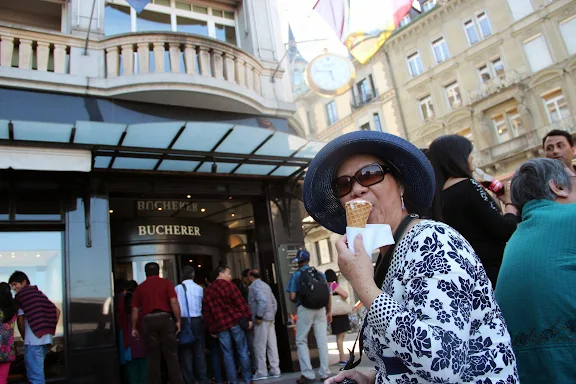
-The Lion Monument or the Lion of Lucerne, is a sculpture in Lucerne, Switzerlan
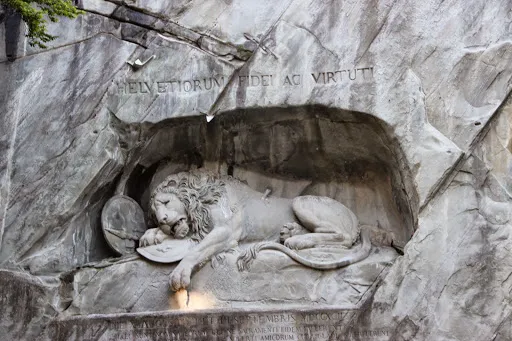
The Lion Monument (German: Löwendenkmal), or the Lion of Lucerne, is a sculpture in Lucerne, Switzerland, designed by Bertel Thorvaldsenand hewn in 1820–21 by Lukas Ahorn. It commemorates the Swiss Guards who were massacred in 1792 during the French Revolution, when revolutionaries stormed the Tuileries Palace in Paris, France. Mark Twain praised the sculpture of a mortally-wounded lion as "the most mournful and moving piece of stone in the world."

- Ju
n 2, 2009 : Switzerland_Swiss Mountain+Lake Lucerne Boat ride
-VIEW :Lucerne Switzerland 360°

Cable car_at the Mt.Stanser

Mt.Stanser


Climbing to the Summit of Mt.Stanser

Playing the Alphorn_Mt.Stanser

Playing the Alphorn_Mt.Stanser

All tourists of our group taking Picture @ the Swiss Heroes monument(t

Chapel Bridge (built in1333)_Lu

-Ju

Lu


Lake Lucerne_Swi
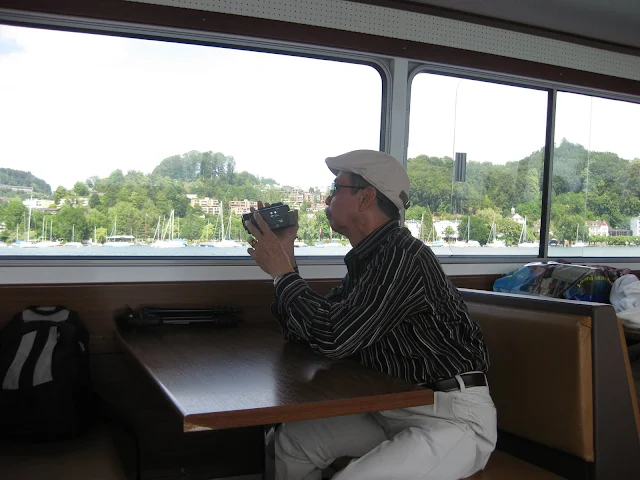

@ Family Burch restaurant in the pretty mountain village of Sarmen_Swi

Ju

La fondue au fromage est un plat chaud ou tiède composé d'un ou plusieurs fromages, tels le gruyère suisse et le vacherin fribourgeois (pour la recette originale suisse). En France, on utilise du beaufort ou du comté. Principal plat national en Suisse avec la raclette, il est également connu depuis les années 1950 en Savoie, en Franche-Comté, dans le Val d'Aoste et dans le Piémont

Cheese Fondue

La fondue savoyarde est un plat régional de la gastronomie savoyarde à base de fromage fondu et de pain, traditionnel de la Savoie
Elle est préparée à partir de produits locaux, tels que le comté, le beaufort, le gruyère de savoie ou l'emmental de savoie, c'est une fondue au fromage.
Avec l'essor des sports d'hiver et du tourisme alpin depuis les années 1950, la fondue savoyarde est devenue une recette de cuisine populaire en France.
Les premières traces de recette à base de fromage fondu remontent à l'antiquité : l'aède Homère, dans son récit l'Iliade, décrit un mets composé de fromage de chèvre râpé fondu, mêlé de vin, et de farine blanche.
En France, la recette de la fondue au fromage est attestée dans la littérature gastronomique depuis au moins 1651, date à laquelle le cuisinier français François Pierre de La Varenneécrit dans son recueil "Le Cuisinier François" une recette à base de fromage fondu et de pain dénommée « Ramequin de fromage ». Le Ramequin étant l’appellation d'un fromage produit dans le département de l'Ain (France), traditionnellement consommé sous la forme de fondue (encore de nos jours) :
« 47. Ramequin de fromage. Prenez du fromage, faites le fondre avec du beurre, oignon entier, ou pillé, sel & poivre à force, estendez le tout sur du pain passé : la paisle du feu par dessus, & servez chaud. »
— François Pierre de La Varenne, Le Cuisinier François (1651), page 104 et 105
En 1734, le chef cuisinier et écrivain culinaire français Vincent La Chapelle décrit dans son ouvrage "Le Cuisinier" une recette proche de celle connue aujourd'hui, à base de fromage, de vin blanc (voire de Champagne), de muscade, de rocambole (variété d'ail) et de pain grillé :
« Fonduë de Fromage, aux Truffes fraiches. Ayez de bon Fromage de gruyere ou parmesan, ou autres bons Fromages, & en mettez, selon la quantité que vous voudrez faire de Fonduë, le tout coupez par petites tranches ou rapé ; mettez-le dans un plat, avec un demi verre d'eau, ou bien de bon vin blanc ; assaisonnez-le de poivre concassé, un peu de muscade, du persil, des ciboules, & quelques Truffes fraiches hachées fort fin ; mettez vôtre plat sur un petit fourneau ou rechaud, & y mettez un morceau de beurre, de la grosseur d'un œuf, & quand vôtre Fonduë commencera à fondre, vous aurez soin de la remuer avec ce que vous jugerez à propos. Etant fonduë, vous aurez un couple de blancs d'œufs foüettés en nège, que vous jetterez dedans, & le jaune. Vous aurez aussi des moüillettes de pain que vous frirez, ou grillerez, longues comme le doigt, que vous mettrez dans la Fonduë, tout autour de vôtre plat. Ajoutez-y un jus d'orange, & servez chaudement. Une autrefois, vous la pouvez faire sans truffes, si vous voulez, & sans persil, ni ciboules, en y ajoutant une rocambole, échalotte, pesil, & un verre de vin de Champagne. »
— Vincent La Chapelle, Le Cuisinier, seconde édition (1742), page 220
En 1794, le gastronome français Jean Anthelme Brillat-Savarin rédige une autre recette de la fondue, à base de gruyère, d'œufs et de beurre, mais servie sans pain et sans adjonction de vin (dégusté séparément pendant le repas, et sans précision sur un cépage rouge ou blanc). Cette recette décrite comme d'origine suisse, ressemble à une sorte d'œuf brouillé (texture mollet) , et diffère de la recette française rédigée précédemment en 1734 par Vincent la Chapelle comprenant de son coté vin blanc, ail, et noix de muscade.
Switzerland – The Cheese Fondue
 During the 18th century the origin of fondue began in Switzerland as a way to use aged cheeses and breads to feed families who had limited access to fresh foods during the winter time. Producers of cheese and bread saw their busy season was during the warm months and that the food had to be saved by villagers to be used through the cold winter months. As the cheese would age and the breads became stale it became more difficult to eat. The local villagers found that if they heated the cheese with wines, garlic, and herbs they could dip their stale bread which would soften when dipped into the flavorful cheese mixture. This way of cooking together over one pot and eating by a warm cozy fire became a Swiss winter tradition known as fondue. The word fondue comes from the French word, ‘fondre’, which means ‘to melt’ and has since then been used to reference many other types of fondue for meats, chicken, seafood, and even chocolate.
During the 18th century the origin of fondue began in Switzerland as a way to use aged cheeses and breads to feed families who had limited access to fresh foods during the winter time. Producers of cheese and bread saw their busy season was during the warm months and that the food had to be saved by villagers to be used through the cold winter months. As the cheese would age and the breads became stale it became more difficult to eat. The local villagers found that if they heated the cheese with wines, garlic, and herbs they could dip their stale bread which would soften when dipped into the flavorful cheese mixture. This way of cooking together over one pot and eating by a warm cozy fire became a Swiss winter tradition known as fondue. The word fondue comes from the French word, ‘fondre’, which means ‘to melt’ and has since then been used to reference many other types of fondue for meats, chicken, seafood, and even chocolate.
-Fondue

Dipping a cheese fondue with a long-stemmed fork
Fondue (/ˈfɒndjuː/ or /ˈfɒnduː/; is a Swiss, Italian, and French dish of melted cheese served in a communal pot (caquelon or fondue pot) over a chafing stand (réchaud) heated with a candle or spirit lamp, and eaten by dipping bread into the cheese using long-stemmed forks. It was promoted as a Swiss national dish by the Swiss Cheese Union (Schweizerische Käseunion) in the 1930s, and was popularized in North America in the 1960s.
Since the 1950s, the name "fondue" has been generalized to other dishes in which a food is dipped into a communal pot of liquid kept hot in a fondue pot: chocolate fondue, in which pieces of fruit are dipped into a melted chocolate mixture, and fondue bourguignonne, in which pieces of meat are cooked in hot oil.
- 2009_06_01 : Switzerland_Lugano Lake
Lugano (Italian: Lugano; Ticinese: Lügàn) is a city in southern Switzerland, in the Italian-speaking canton of Ticino, which borders Italy. The population of the city proper was 61,837 as of December 2012, and the population of the urban agglomeration was over 145,000. It is the 9th largest city of Switzerland by population, the largest city in Ticino, and the largest city with an Italian speaking majority outside of Italy.
The city lies on Lake Lugano, surrounded by the mountains of the Lugano Prealps. Its warm summers and the fact that in recent years it has attracted an ever growing number of celebrities, entertainers and successful athletes have given it the nickname of the "Monte Carlo of Switzerland"
The city lies on Lake Lugano, surrounded by the mountains of the Lugano Prealps. Its warm summers and the fact that in recent years it has attracted an ever growing number of celebrities, entertainers and successful athletes have given it the nickname of the "Monte Carlo of Switzerland"

Switzerlan





Ju

Lugano,Swi

Ju



-VIDEO : Switzerland from Above - Top Sights (HD)_(2013)
Visiting: Lake Garda_Verona_Venice_Rome_Vatican_
Florence_Pisa.
-VIDEO : Travel to Italy : Explore the Magnificence of Each Region and Visit Italy
-VIDEO : Italy from Above - our best sights from Verona, Venice, Vicenza & more (HD)
-VIDEO :Rome, Florence, Pisa, Venice Italy (2015)
-2009_05_30_Lake Garda_ItalyLake Garda (Italian: Lago di Garda or Lago Benaco) is the largest lake in Italy. It is a popular holiday location and is located in Northern Italy, about half-way between Brescia and Verona, and between Venice and Milan. Glaciers formed this alpine region at the end of the last Ice Age. The lake and its shoreline are divided between the provinces of Verona (to the south-east), Brescia (south-west), and Trentino (north).



Lake Garda_Ital

Lake Garda_Ital

Milano - Duomo_January 31, 2009_Milan Cathedral (Italian: Duomo di Milano; Lombard: Domm de Milan) is the cathedral churchof Milan, Italy. Dedicated to St Mary of the Nativity (Santa Maria Nascente), it is the seat of the Archbishop of Milan, currently Cardinal Angelo Scola. The Gothic cathedral took nearly six centuries to complete. It is the 5th-largest church in the world and the largest in Italy
PHOTO SPHERE - Jun 2016:
-VIEW :360° virtual tour of Arena di Verona
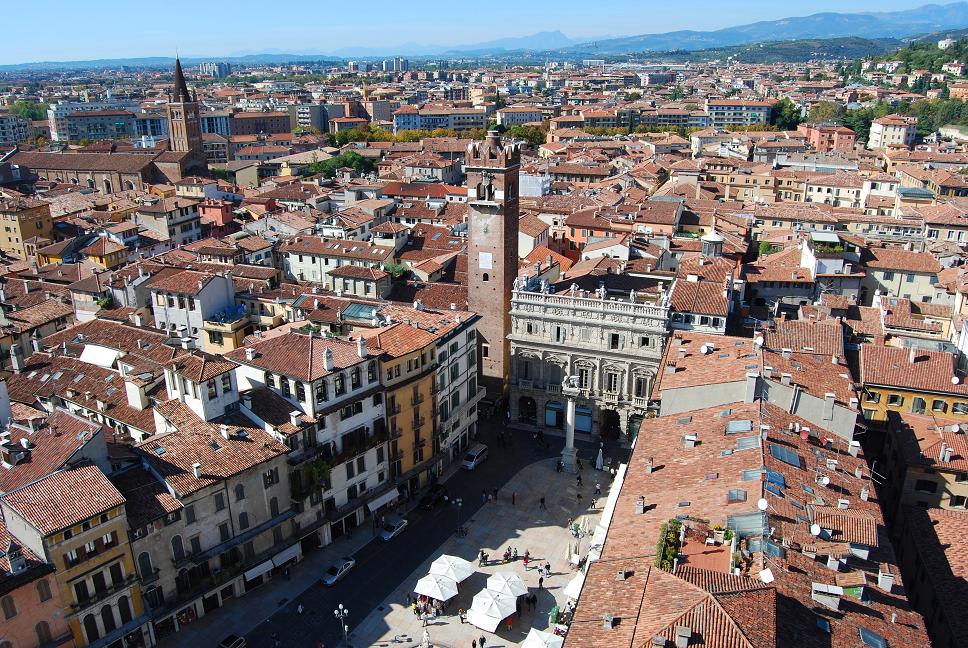
Verona - piazza Erbe from Lamberti tower

Panoramic view of the city from Castel San Pietro. -Verona_Italy :
Verona ( Venetian Verona, Veròna) is a city straddling the Adige river in Veneto, northern Italy, with approximately 265,000 inhabitants and one of the sevenchef-lieus of the region. It is the second largest city municipality in the region and the third ofnortheast Italy. The metropolitan area of Verona covers an area of 1,426 km2 (550.58 sq mi) and has a population of 714,274 inhabitants. It is one of the main tourist destinations in northern Italy, owing to its artistic heritage, several annual fairs, shows, and operas, such as the lyrical season in the Arena, the ancient amphitheatre built by the Romans.
The city has been awarded World Heritage Site status by UNESCO because of its urban structure and architecture.
The precise details of Verona's early history remain a mystery. The origin of the name Verona is also unknown. One theory is it was a city of the Euganei, who were obliged to give it up to the Cenomani (550 BC). With the conquest of the Valley of the Po the Veronese territory became Roman (about 300 BC). Verona became a Roman colonia in 89 BC, and then a municipium in 49 BC; Verona had the franchise in 59.
The city became important because it was at the intersection of several roads.Stilicho defeated Alaric and his Visigoths here in 403. But, after Verona was conquered by the Ostrogoths in 489, the Gothic domination of Italy began.Theoderic the Great was said to have built a palace there, and according to Irish legends that is what Verona was named after.[clarification needed] It remained under the power of the Goths throughout the Gothic War (535–552), except for a single day in 541, when the Byzantine officer Artabazes made an entrance. The defections that took place among the Byzantine generals with regard to the booty made it possible for the Goths to regain possession of the city. In 552 Valerian vainly endeavored to enter the city, but it was only when they were fully overthrown that the Goths surrendered it.
In 569, it was taken by Alboin, King of the Lombards, in whose kingdom it was, in a sense, the second most important city. There, Alboin himself was killed by his own wife in 572. The dukes of Treviso often resided there. At Verona Adalgisus, son ofDesiderius, in 774 made his last desperate resistance to Charlemagne, who had destroyed the Lombard kingdom. Verona was then the ordinary residence of the kings of Italy, the government of the city becoming hereditary in the family of Count Milo, progenitor of the counts of San Bonifacio. From 880 to 951 the two Berengarii resided there. Otto I ceded to Verona the marquisate dependent on the Duchy ofBavaria.
When Ezzelino III da Romano was elected podestà, in 1226, he was able to convert the office into a permanent lordship, and in 1257 he caused the slaughter of 11,000 Paduans on the plain of Verona (Campi di Verona). Upon his death the Great Council elected as podestà Mastino I della Scala, and he converted the "signoria" into a family possession, though leaving the burghers a share in the government. Failing to be re-elected podestà in 1262, he effected a coup d'état, and was acclaimed capitano del popolo, with the command of the communal troops. It was not without long internal discord that he succeeded in establishing this new office, to which was attached the function of confirming the podestà. In 1277, Mastino dello Scala was killed by the faction of the nobles.
The reign of his son Alberto as capitano (1277–1302) was one incessant war against the counts of San Bonifacio, who were aided by the House of Este. Of his sons, Bartolomeo, Alboino andCangrande I, only the last shared the government (1308); he was great as warrior, prince, and patron of the arts; he protected Dante, Petrarch, and Giotto. By war or treaty, he brought under his control the cities of Padua (1328), Treviso (1308) and Vicenza. At this time before the Black deaththe city was home to more than 40,000 people.
Alberto was succeeded by Mastino II (1329–1351) and Alberto, sons of Alboino. Mastino continued his uncle's policy, conquering Brescia in 1332 and carrying his power beyond the Po. He purchased Parma (1335) and Lucca (1339). After the King of France, he was the richest prince of his time. But a powerful league was formed against him in 1337 – Florence,Venice, the Visconti, the Este, and the Gonzaga. After a three years war, the Scaliger dominions were reduced to Verona andVicenza (Mastino's daughter Regina-Beatrice della Scala married to Barnabò Visconti). Mastino's son Cangrande II (1351–1359) was a cruel, dissolute, and suspicious tyrant; not trusting his own subjects, he surrounded himself with Brandenburg mercenaries. He was killed by his brother Cansignorio (1359–1375), who beautified the city with palaces, provided it with aqueducts and bridges, and founded the state treasury. He also killed his other brother, Paolo Alboino. Fratricide seems to have become a family custom, for Antonio (1375–87), Cansignorio's natural brother, slew his brother Bartolomeo, thereby arousing the indignation of the people, who deserted him when Gian Galeazzo Visconti of Milan made war on him. Having exhausted all his resources, he fled from Verona at midnight (19 October 1387), thus putting an end to the Scaliger domination, which, however, survived in its monuments.
The year 1387 is also the year of the famous Battle of Castagnaro, between Giovanni Ordelaffi, for Verona, and John Hawkwood, for Padua, who was the winner.
Antonio's son Canfrancesco in vain attempted to recover Verona (1390).
Guglielmo (1404), natural son of Cangrande II, was more fortunate; with the support of the people, he drove out the Milanese, but he died ten days after, and Verona then submitted to Venice (1405). The last representatives of the Scaligeri lived at the imperial court and repeatedly attempted to recover Verona by the aid of popular risings.
From 1508 to 1517, the city was in the power of the Emperor Maximilian I. There were numerous outbreaks of the plague, and in1629–33 Italy was struck by its worst outbreak in modern times. Around 33,000 people died in Verona (over 60 per cent of the population) in 1630–1631.
In 1776 was developed a method of bellringing called Veronese bellringing art. Verona was occupied by Napoleon in 1797, but onEaster Monday the populace rose and drove out the French. It was then that Napoleon made an end of the Venetian Republic. Verona became Austrian territory when Napoleon signed the Treaty of Campo Formio in October, 1797. The Austrians took control of the city on January 18, 1798. It was taken from Austria by the Treaty of Pressburg in 1805 and became part of Napoleon'sKingdom of Italy, but was returned to Austria following Napoleon's defeat in 1814, when it became part of the Austrian-held Kingdom of Lombardy-Venetia. In 1866, following the Six Weeks War, Verona, along with the rest of Venetia, became part of Italy.
The advent of fascism added another dark chapter to the annals of Verona. As throughout Italy, the Jewish population was hit by theManifesto of Race, a series of anti-Semitic laws passed in 1938, and after the invasion by Nazi Germany in 1943, deportations toNazi concentration camps. An Austrian Fort (now a church, the Santuario della Madonna di Lourdes), was used to incarcerate and torture Allied troops, Jews and anti-fascists, especially after 1943, when Verona became part of the Italian Social Republic.
As in Austrian times, Verona became of great strategic importance to the regime. Galeazzo Ciano, Benito Mussolini's son-in-law, was accused of plotting against the republic; in a show trial staged by the Nazi and fascist hierarchy at Castelvecchio (the Verona trial), Ciano was executed on the banks of the Adige with many other officers on what is today Via Colombo. This marked another turning point in the escalation of violence that would only end with the final liberation by allied troops and partisans in 1945.
After World War II, as Italy entered into NATO, Verona once again acquired its strategic importance, due to its closeness to the Iron Curtain. The city became the seat of SETAF (South European Allied Terrestrial Forces) and had during the whole duration of the Cold War period a strong military presence, especially American, which is decreasing only in these recent years. Now Verona is an important and dynamic city, very active in terms of economy, and also a very important tourist attraction because of its history, where the Roman past lives side by side with the Middle Age Verona, which in some senses brings about its architectural and artistic motifs.
The city has been awarded World Heritage Site status by UNESCO because of its urban structure and architecture.
The precise details of Verona's early history remain a mystery. The origin of the name Verona is also unknown. One theory is it was a city of the Euganei, who were obliged to give it up to the Cenomani (550 BC). With the conquest of the Valley of the Po the Veronese territory became Roman (about 300 BC). Verona became a Roman colonia in 89 BC, and then a municipium in 49 BC; Verona had the franchise in 59.
The city became important because it was at the intersection of several roads.Stilicho defeated Alaric and his Visigoths here in 403. But, after Verona was conquered by the Ostrogoths in 489, the Gothic domination of Italy began.Theoderic the Great was said to have built a palace there, and according to Irish legends that is what Verona was named after.[clarification needed] It remained under the power of the Goths throughout the Gothic War (535–552), except for a single day in 541, when the Byzantine officer Artabazes made an entrance. The defections that took place among the Byzantine generals with regard to the booty made it possible for the Goths to regain possession of the city. In 552 Valerian vainly endeavored to enter the city, but it was only when they were fully overthrown that the Goths surrendered it.
In 569, it was taken by Alboin, King of the Lombards, in whose kingdom it was, in a sense, the second most important city. There, Alboin himself was killed by his own wife in 572. The dukes of Treviso often resided there. At Verona Adalgisus, son ofDesiderius, in 774 made his last desperate resistance to Charlemagne, who had destroyed the Lombard kingdom. Verona was then the ordinary residence of the kings of Italy, the government of the city becoming hereditary in the family of Count Milo, progenitor of the counts of San Bonifacio. From 880 to 951 the two Berengarii resided there. Otto I ceded to Verona the marquisate dependent on the Duchy ofBavaria.
When Ezzelino III da Romano was elected podestà, in 1226, he was able to convert the office into a permanent lordship, and in 1257 he caused the slaughter of 11,000 Paduans on the plain of Verona (Campi di Verona). Upon his death the Great Council elected as podestà Mastino I della Scala, and he converted the "signoria" into a family possession, though leaving the burghers a share in the government. Failing to be re-elected podestà in 1262, he effected a coup d'état, and was acclaimed capitano del popolo, with the command of the communal troops. It was not without long internal discord that he succeeded in establishing this new office, to which was attached the function of confirming the podestà. In 1277, Mastino dello Scala was killed by the faction of the nobles.
The reign of his son Alberto as capitano (1277–1302) was one incessant war against the counts of San Bonifacio, who were aided by the House of Este. Of his sons, Bartolomeo, Alboino andCangrande I, only the last shared the government (1308); he was great as warrior, prince, and patron of the arts; he protected Dante, Petrarch, and Giotto. By war or treaty, he brought under his control the cities of Padua (1328), Treviso (1308) and Vicenza. At this time before the Black deaththe city was home to more than 40,000 people.
Alberto was succeeded by Mastino II (1329–1351) and Alberto, sons of Alboino. Mastino continued his uncle's policy, conquering Brescia in 1332 and carrying his power beyond the Po. He purchased Parma (1335) and Lucca (1339). After the King of France, he was the richest prince of his time. But a powerful league was formed against him in 1337 – Florence,Venice, the Visconti, the Este, and the Gonzaga. After a three years war, the Scaliger dominions were reduced to Verona andVicenza (Mastino's daughter Regina-Beatrice della Scala married to Barnabò Visconti). Mastino's son Cangrande II (1351–1359) was a cruel, dissolute, and suspicious tyrant; not trusting his own subjects, he surrounded himself with Brandenburg mercenaries. He was killed by his brother Cansignorio (1359–1375), who beautified the city with palaces, provided it with aqueducts and bridges, and founded the state treasury. He also killed his other brother, Paolo Alboino. Fratricide seems to have become a family custom, for Antonio (1375–87), Cansignorio's natural brother, slew his brother Bartolomeo, thereby arousing the indignation of the people, who deserted him when Gian Galeazzo Visconti of Milan made war on him. Having exhausted all his resources, he fled from Verona at midnight (19 October 1387), thus putting an end to the Scaliger domination, which, however, survived in its monuments.
The year 1387 is also the year of the famous Battle of Castagnaro, between Giovanni Ordelaffi, for Verona, and John Hawkwood, for Padua, who was the winner.
Antonio's son Canfrancesco in vain attempted to recover Verona (1390).
Guglielmo (1404), natural son of Cangrande II, was more fortunate; with the support of the people, he drove out the Milanese, but he died ten days after, and Verona then submitted to Venice (1405). The last representatives of the Scaligeri lived at the imperial court and repeatedly attempted to recover Verona by the aid of popular risings.
From 1508 to 1517, the city was in the power of the Emperor Maximilian I. There were numerous outbreaks of the plague, and in1629–33 Italy was struck by its worst outbreak in modern times. Around 33,000 people died in Verona (over 60 per cent of the population) in 1630–1631.
In 1776 was developed a method of bellringing called Veronese bellringing art. Verona was occupied by Napoleon in 1797, but onEaster Monday the populace rose and drove out the French. It was then that Napoleon made an end of the Venetian Republic. Verona became Austrian territory when Napoleon signed the Treaty of Campo Formio in October, 1797. The Austrians took control of the city on January 18, 1798. It was taken from Austria by the Treaty of Pressburg in 1805 and became part of Napoleon'sKingdom of Italy, but was returned to Austria following Napoleon's defeat in 1814, when it became part of the Austrian-held Kingdom of Lombardy-Venetia. In 1866, following the Six Weeks War, Verona, along with the rest of Venetia, became part of Italy.
The advent of fascism added another dark chapter to the annals of Verona. As throughout Italy, the Jewish population was hit by theManifesto of Race, a series of anti-Semitic laws passed in 1938, and after the invasion by Nazi Germany in 1943, deportations toNazi concentration camps. An Austrian Fort (now a church, the Santuario della Madonna di Lourdes), was used to incarcerate and torture Allied troops, Jews and anti-fascists, especially after 1943, when Verona became part of the Italian Social Republic.
As in Austrian times, Verona became of great strategic importance to the regime. Galeazzo Ciano, Benito Mussolini's son-in-law, was accused of plotting against the republic; in a show trial staged by the Nazi and fascist hierarchy at Castelvecchio (the Verona trial), Ciano was executed on the banks of the Adige with many other officers on what is today Via Colombo. This marked another turning point in the escalation of violence that would only end with the final liberation by allied troops and partisans in 1945.
After World War II, as Italy entered into NATO, Verona once again acquired its strategic importance, due to its closeness to the Iron Curtain. The city became the seat of SETAF (South European Allied Terrestrial Forces) and had during the whole duration of the Cold War period a strong military presence, especially American, which is decreasing only in these recent years. Now Verona is an important and dynamic city, very active in terms of economy, and also a very important tourist attraction because of its history, where the Roman past lives side by side with the Middle Age Verona, which in some senses brings about its architectural and artistic motifs.

Verona_Ita

Verona arena 2009
The Roman military settlement in what is now the centre of the city was to expand through the cardiand decumani that intersect at right angles. This structure has been kept to the present day and is clearly visible from the air. Further development has not reshaped the original map. Though the Roman city with its basalt-paved roads is mostly hidden from view it stands virtually intact about 6 m below the surface. Most palazzi and houses have cellars built on Roman artifacts that are rarely accessible to visitors. Piazza delle Erbe, near the Roman forum was rebuilt by Cangrande Iand Cansignorio della Scala I, lords of Verona, using material (such as marble blocks and statues) from Roman spas and villas.
Verona is famous for its Roman amphitheatre, the Arena found in the city's largest piazza, the Piazza Bra. Completed around 30 AD, it is the third largest in Italy after Rome's Colosseum and the arena at Capua. It measures 139 metres long and 110 metres wide, and could seat some 25,000 spectators in its 44 tiers of marble seats. The ludi (shows and gladiator games) performed within its walls were so famous that they attracted spectators from far beyond the city. The current two-story façade is actually the internal support for the tiers; only a fragment of the original outer perimeter wall in white and pink limestone from Valpolicella, with three stories remains.The interior is very impressive and is virtually intact, and has remained in use even today for public events, fairs, theatre and open-aired opera during warm summer nights.
There is also a variety of other Roman monuments to be found in the town, such as the Roman theatre of Verona. This theatre was built in the 1st century BC, but through the ages had fallen in disuse and had been built upon to provide housing. In the 18th century Andrea Monga, a wealthy Veronese, bought all the houses that in time had been built over the theatre, demolished them, and saved the monument. Not far from it is the Ponte di Pietra ("Stone Wall Bridge"), another Roman landmark that has survived to this day.
The Arco dei Gavi (Gavi Arch) was built in the 1st century AD, and is famous for having the name of the builder (architect Lucius Vitruvius Cordone) engraved on it, a really rare case in the architecture of the epoque. It originally straddled the main Roman road into the city, now the Corso Cavour. It had been demolished by the French troops in 1805 and was rebuilt in 1932.
Nearby is the Porta Borsari, an archway at the end of Corso Porta Borsari. This is the façade of a 3rd-century gate in the original Roman city walls. The inscription is dated 245 AD and gives the city name as Colonia Verona Augusta. Corso Porta Borsari, the road passing through the gate is the original Via Sacraof the Roman city. Today, it is lined with several Renaissance palazzi and the ancient Church of SS. Apostoli (left), a few metres from Piazza delle Erbe.
Porta Leoni is the 1st century BC ruin of what was once part of the Roman city gate. A substantial portion is still standing as part of the wall of a medieval building. The street itself is an open archaeological site, and the remains of the original Roman street and gateway foundations can be seen a few feet below the present street level. As can be seen from there, the gate contains a small court guarded by towers. Here, carriages and travelers were inspected before entering or leaving the city.
Medieval architecture
The Basilica of San Zeno Maggiore is considered one of the great achievements of Romanesque architecture. The present structure is the third on its site, built from 1123–1135, over the 4th-century shrine to Verona's patron saint, St. Zeno (died 380). The façade dominates the large square, and is flanked with a beautiful 72 metres tall bell tower, which is mentioned by Dante in Canto 18 of Purgatory in the Divine Comedy. The weathered Veronese stone gives a warm golden glow, and the restrained lines of the pillars, columns, and cornices, and the gallery with its double windows, give the façade an air of harmonious elegance. The huge rose window is decorated as a Wheel of Fortune. The lintels above the portal have carvings of the months of the year. Each side of the doorway is embellished with 18 bas-relief panels of biblical scenes, and the inner bronze door panels have 48 primitive but forceful depictions of Biblical scenes and episodes from the life of St Zeno. The meaning of some of the scenes is now unknown, but the extraordinarily vivid, barbaric energy of the figures is a superb blend of traditional and Ottonian influences. The interior of the church is divided into the Lower Church, occupying about 2/3 of the structure, and the Upper Church, occupying the remainder. The walls are covered with 12th and 14th century frescos and the ceiling of the nave is a magnificent example of a ship's keel ceiling. The vaulted crypt contains the tomb of St. Zeno, the first Bishop of Verona, as well as the tombs of several other saints. North of the church is a pleasant cloister. The church also houses the tomb of King Pippin of Italy (777–810).
The small Romanesque Basilica of San Lorenzo is one of the finest and most important in the city. It dates from around 1177, but is built on the site of a Paleochristian church, some fragments of which remain. The church is built of alternating tracks of brick and stone, and has two cylindrical towers, housing spiral staircases to the women's galleries. Inside, the atmosphere is rather severe, but still quiet and peaceful. The striped bands of stone and brick and the graceful arches complement the setting.
With a span length of 48.70 m (159.78 ft), the segmental arch bridge Ponte Scaligero featured, at the time of its the completion in 1356, the world's largest bridge arch.
Santa Maria Antica is a huge Romanesque church that served as the parish church of the Scaligericlan, and is famous for the Gothic Scaliger Tombs. The Duomo is also a notable Romanesque church.
Sant'Anastasia is a huge and lofty church built from 1290–1481 by the Dominicans to hold the massive congregations attracted by their rousing fundamentalist sermons. The Pellegrini chapel houses the famous fresco St. George and the Princess of Trebizond by Pisanello as well as thegrave of Wilhelm von Bibra. The famous square also holds its art festival in May.



Verona_Ita

Verona_Ita

Verona_Ita



The Verona Arena (Arena di Verona) is a Roman amphitheat

2013_06_07_Italy_Verona-The building itself was built in AD 30 on a site which was then beyond the city walls. The ludi (shows and games) staged there were so famous that spectators came from many other places, often far away, to witness them. The amphitheat

2013_06_07_Italy_Verona

-Juliet's house In Verona_Italy:

2013_06_07_Italy_Verona

The balcony of Juliet's house

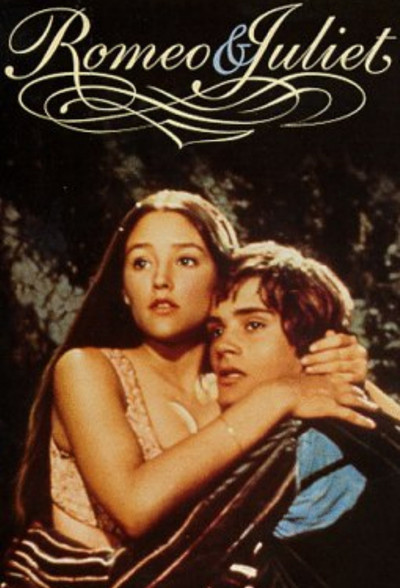

2013_06_07_Italy_Verona


The tower was begun in 1172; in May 1403 a lightning bolt struck the top of the tower, but only in 1448 restoration works were started, lasting until 1464. In the occasion the tower was enlarged: the more recent sections can be recognized today by the use of different materials (such as marble). The large clock was added in 1779.
The tower has four bells: the Marangona signals fires, work times, and the hours of the day, while the largest, called Rengo, is used to call the population to arms or to invoke the city's councils.


2013_06_07_Italy_Verona


Piazza dei Signori, Verona, Veneto, Italy. Also called Piazza Dante due to the poet's statue in the center of the place. On the left is the 12C Town Hall, also known as the Palazzo della Ragione. This building is connected by an arch to the Law Courts, formerly Palazzo del Capitano. The Torre dei Lamberti dominates the place with its 84m high.
-The fountain of Madonna Verona, which was repaired in 1368, is one of the oldest and best known fountains in the city :

2013_06_07_Italy_Verona_The fountain of Madonna Verona, which was repaired in 1368, is one of the oldest and best known fountains in the city.


Piazza delle Erbe (Market's square) is a square in Verona, northern Italy. It was once the town'sforum during the time of the Roman Empire.
The northern side of the square is occupied by the ancient town hall, the Torre dei Lamberti, theCasa dei Giudici ("Judges' Hall") and the frescoed Mazzanti Houses. The western side, the shortest one, features the Baroque Palazzo Maffei, decorated by statues of Greek gods. It is faced by a white marble column, on which is St. Mark's Lion, symbol of the Republic of Venice.
The north-western side occupies the site of the ancient Roman Capitol Hill, which looked towards the forum. Numerous of its buildings facing the square have maintained façade frescoes. On the southern side is the crenllated Casa dei Mercanti ("House of the Merchants", also known asDomus Mercatorum), now the seat of the Banca Popolare di Verona. Other buildings, the tall houses of the Ghetto, are reminiscent of medieval tower-houses.
The square's most ancient monument is the fountain (built in 1368 by Cansignorio della Scala), surmounted by a statue called Madonna Verona, which is however a Roman sculpture dating to 380 AD. Also historical is the capitello, dating to the 13th century, during which it was used for several ceremonies, including the oath of investment of the city's medieval podestà and pretors. Towards Via Cappello is another column, with a 14th-century aedicula with reliefs of the Virgin and the Saints Zeno, Peter and Christopher.

Palazzo Maffei is a historical palace in Verona, northern Italy, on the north-western side of Piazza delle Erbe.

Verona-piazza delle erbe

2013_06_07_Italy_Verona
= "my sunshine"
-2013_06_08_Venice_Italy:
-Click on : Venice, Italy • 360° Aerial Panorama
http://www.airpano.ru/files/Italy-Venice/2-2
Venice (Italian: Venezia [veˈnɛttsia] ,alternative obsolete form: Vinegia;Venetian: Venexia [veˈnɛsja]; Latin: Venetia; Slovene: Benetke) is a city in northeastern Italy sited on a group of 118 small islands separated by canals and linked by bridges. It is located in the marshy Venetian Lagoon which stretches along the shoreline, between the mouths of the Po and the Piave Rivers. Venice is renowned for the beauty of its setting, its architecture and its artworks. The city in its entirety is listed as a World Heritage Site, along with its lagoon.
Venice is the capital of the Veneto region. In 2009, there were 270,098 people residing in Venice's comune (the population estimate of 272,000 inhabitants includes the population of the whole Comuneof Venezia; around 60,000 in the historic city of Venice (Centro storico); 176,000 in Terraferma(the Mainland), mostly in the large frazioni of Mestre and Marghera; 31,000 live on other islands in the lagoon). Together with Padua and Treviso, the city is included in the Padua-Treviso-Venice Metropolitan Area (PATREVE), with a total population of 1,600,000. PATREVE is only a statistical metropolitan area without any degree of autonomy.
The name is derived from the ancient Veneti people who inhabited the region by the 10th century BC. The city historically was the capital of the Republic of Venice. Venice has been known as the "La Dominante", "Serenissima", "Queen of the Adriatic", "City of Water", "City of Masks", "City of Bridges", "The Floating City", and "City of Canals". Luigi Barzini described it in The New York Times as "undoubtedly the most beautiful city built by man" .Venice has also been described by the Times Online as being one of Europe's most romantic cities.
The Republic of Venice was a major maritime power during the Middle Ages and Renaissance, and a staging area for the Crusades and the Battle of Lepanto, as well as a very important center of commerce (especially silk, grain, and spice) and art in the 13th century up to the end of the 17th century. This made Venice a wealthy city throughout most of its history. It is also known for its several important artistic movements, especially the Renaissance period. Venice has played an important role in the history of symphonic and operatic music, and it is the birthplace of Antonio Vivaldi.
-VIDEO : Venice, Italy
Venice is the capital of the Veneto region. In 2009, there were 270,098 people residing in Venice's comune (the population estimate of 272,000 inhabitants includes the population of the whole Comuneof Venezia; around 60,000 in the historic city of Venice (Centro storico); 176,000 in Terraferma(the Mainland), mostly in the large frazioni of Mestre and Marghera; 31,000 live on other islands in the lagoon). Together with Padua and Treviso, the city is included in the Padua-Treviso-Venice Metropolitan Area (PATREVE), with a total population of 1,600,000. PATREVE is only a statistical metropolitan area without any degree of autonomy.
The name is derived from the ancient Veneti people who inhabited the region by the 10th century BC. The city historically was the capital of the Republic of Venice. Venice has been known as the "La Dominante", "Serenissima", "Queen of the Adriatic", "City of Water", "City of Masks", "City of Bridges", "The Floating City", and "City of Canals". Luigi Barzini described it in The New York Times as "undoubtedly the most beautiful city built by man" .Venice has also been described by the Times Online as being one of Europe's most romantic cities.
The Republic of Venice was a major maritime power during the Middle Ages and Renaissance, and a staging area for the Crusades and the Battle of Lepanto, as well as a very important center of commerce (especially silk, grain, and spice) and art in the 13th century up to the end of the 17th century. This made Venice a wealthy city throughout most of its history. It is also known for its several important artistic movements, especially the Renaissance period. Venice has played an important role in the history of symphonic and operatic music, and it is the birthplace of Antonio Vivaldi.
-VIDEO : Venice, Italy


2013_06_08_Venice_Italy

2013_06_08
















The 1887 bronze equestrian monument to Victor Emmanuel II in Venice, modelled by Ettore Ferrari (1848-1929), stands on the Riva degli Schiavoni.

Gondola Ride_2013_06_08

The Bridge of Sighs:





The Doges'Pala

The courtyard of the Doges'Pala


The Staircase of the Giants with
the statues of Mars and Neptune



The Golden Staircase


The Doge's Palace is a palace built in Venetian Gothic style, and one of
the main landmarks of the city of Venice, northern Italy

Piazzetta San Marco and Libreria Marciana


Piazza San Marco with the Basilica, by Canaletto, 1730. Fogg Art Museum, Cambridge

Gentile Bellini: Procession in the Piazza San Marco. This shows the Piazza in 1496
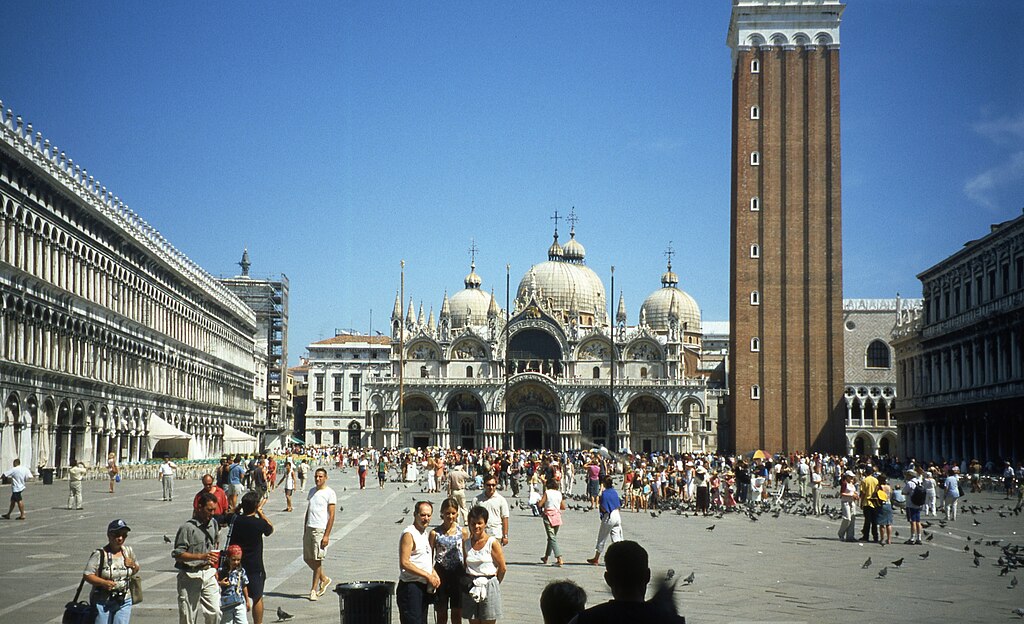
Piazza San Marco

The west facade of St Mark's basilica


The Clocktower with the archway into the Mercerie leading to the Rialto


Saint Mark's Basilica in Venice_Italy_2013_06_08

The Loggetta at the foot of the Campanile (built by Sansovino 1537-46); rebuilt after the fall of Campanile in 1902

St Mark's Campanile is the bell tower of St Mark's Basilica in Venice,loc

The Piazza seen from above (from the Campanile)

Venice – St. Marcus Square – Procuratie Vecchie_Procuratie Vecchie built by Bartolomeo Bon the Younger (about 1520)

the Clocktower was built during 1496 and 1497
The Patriarchal Cathedral Basilica of Saint Mark (officially known in Italian as the Basilica Cattedrale Patriarcale di San Marco and commonly known as Saint Mark's Basilica) is the cathedral church of the Roman Catholic Archdiocese of Venice, northern Italy. It is the most famous of the city's churches and one of the best known examples of Italo-Byzantine architecture. It lies at the eastern end of the Piazza San Marco, adjacent and connected to the Doge's Palace. Originally it was the chapel of the Doge, and has only been the city's cathedral since 1807, when it became the seat of the Patriarch of Venice, archbishop of the Roman Catholic Archdiocese of Venice, formerly at San Pietro di Castello.


The west end of the Piazza showing the Ala Napoleonic



The Winged Lion:symbo
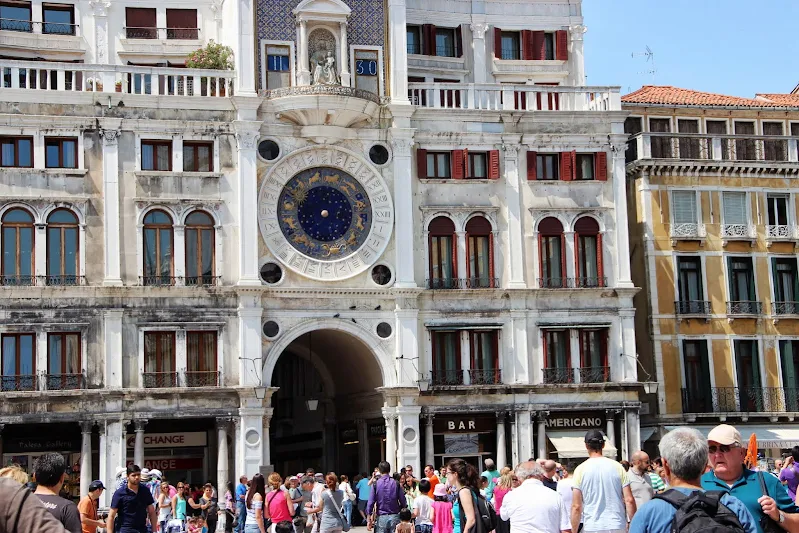









The Rialto Bridge (Italian: Ponte di Rialto) is one of the four bridges spanning the Grand Canal in Venice, Italy. It is the oldest bridge across the canal, and was the dividing line for the districts of San Marco and San Polo.
The first dry crossing of the Grand Canal was a pontoon bridge built in 1181 by Nicolò Barattieri. It was called the Ponte della Moneta, presumably because of the mint that stood near its eastern entrance.
The development and importance of the Rialto market on the eastern bank increased traffic on the floating bridge, so it was replaced in 1255 by a wooden bridge. This structure had two inclined ramps meeting at a movable central section, that could be raised to allow the passage of tall ships. The connection with the market eventually led to a change of name for the bridge. During the first half of the 15th century, two rows of shops were built along the sides of the bridge. The rents brought an income to the State Treasury, which helped maintain the bridge.
Maintenance was vital for the timber bridge. It was partly burnt in the revolt led by Bajamonte Tiepolo in 1310. In 1444, it collapsed under the weight of a crowd watching a boat parade and it collapsed again in 1524.
The idea of rebuilding the bridge in stone was first proposed in 1503. Several projects were considered over the following decades. In 1551, the authorities requested proposals for the renewal of the Rialto Bridge, among other things. Plans were offered by famous architects, such as Jacopo Sansovino, Palladio and Vignola, but all involved a Classical approach with several arches, which was judged inappropriate to the situation. Michelangelo also was considered as designer of the bridge.
The present stone bridge, a single span designed by Antonio da Ponte, was finally completed in 1591. It is similar to the wooden bridge it succeeded. Two inclined ramps lead up to a central portico. On either side of the portico, the covered ramps carry rows of shops. The engineering of the bridge was considered so audacious that architect Vincenzo Scamozzi predicted future ruin. The bridge has defied its critics to become one of the architectural icons of Venice.


_2009_05_31



Rialto Bridge Grand Canal

The Rialto Bridge
Constructi
Constructi

Two gondoliers pull out with clients on board from a row of gondolas on the Grand Canal near Rialto Bridge.







_2009_05_31


Doge's Palace, Venice_Italy_2009_05_31

Gondola Ride
_2009_05_31

Dinner In Venice_Italy_May 31, 2009

2009_05_31_Venice

Gondola Ride in Venice_Italy_2009_05_31
-VIEW :Venecia 2010

-VIEW :Venecia 2010
-VIDEO :Time To Say Goodbye !
Andrea Bocelli and Sarah Brightman: Time To Say Goodbye (Live From Teatro Del Silenzio, Italy / 2007)

Gondola


-VIDEO :Best Travel Video - Visions of Venice_2013
-VIDEO : Venice Carnival 2014 - the best masks - Carnevale di Venezia 2014 - by Giovanni Rosin
Andrea Bocelli & Sarah Brightman. (English Subtitles).Lyrics
-VENICE - ITALY 2017 _ 4K Video: :
-Venice, Italy_2017 :
-2013_06_09_Rome_Italy :
Rome (/ˈroʊm/; Italian: Roma ) is a city and special comune (named "Roma Capitale") in Italy. Rome is the capital of Italy and also of the homonymous province and of the region of Lazio. With 2.7 million residents in 1,285.3 km2 (496.3 sq mi), it is also the country's largest and most populated comune and fourth-most populous city in the European Union by population within city limits. The urban area of Rome extends beyond the administrative city limits with a population of around 3.8 million. Between 3.2 and 4.2 million people live in Rome metropolitan area. The city is located in the central-western portion of the Italian Peninsula, on the Tiber within Lazio (Latium). Rome is the only city in the world to contain in its interior a whole state; the enclave of Vatican City.
Rome's history spans more than two and a half thousand years, since its legendary founding in 753 BC. Rome is one of the oldest continuously occupied cities in Europe. It is referred to as "The Eternal City", a notion expressed by ancient Roman poets and writers. In the ancient world it was successively the capital city of the Roman Kingdom, the Roman Republic and the Roman Empire, and is regarded as one of the birthplaces of Western civilization. Since the 1st century AD, Rome has been considered the seat of the Papacy and in the 8th century it became the capital of thePapal States, which lasted until 1870. In 1871 Rome became the capital of the Kingdom of Italy, and in 1946 that of the Italian Republic.
After the Middle Ages, Rome was ruled by popes such as Alexander VI and Leo X, who transformed the city into one of the major centers of the Italian Renaissance along with Florence.The current version of St Peter's Basilica was built and the Sistine Chapel was painted by Michelangelo. Famous artists and architects, such as Bramante, Bernini and Raphael, resided for some time in Rome, contributing to its Renaissance and Baroque architecture.
Rome has a status of the global city. In 2007, Rome was the 11th-most-visited city in the world, 3rd most visited in the European Union, and the most popular tourist attraction in Italy.The city is one of Europe's and the world's most successful city "brands", both in terms of reputation and assets. Its historic centre is listed by UNESCO as a World Heritage Site.Monuments and museums such as the Vatican Museums and the Colosseum are among the world's most visited tourist destinations with both locations receiving millions of tourists a year. Rome hosted the 1960 Summer Olympics.
Rome's history spans more than two and a half thousand years, since its legendary founding in 753 BC. Rome is one of the oldest continuously occupied cities in Europe. It is referred to as "The Eternal City", a notion expressed by ancient Roman poets and writers. In the ancient world it was successively the capital city of the Roman Kingdom, the Roman Republic and the Roman Empire, and is regarded as one of the birthplaces of Western civilization. Since the 1st century AD, Rome has been considered the seat of the Papacy and in the 8th century it became the capital of thePapal States, which lasted until 1870. In 1871 Rome became the capital of the Kingdom of Italy, and in 1946 that of the Italian Republic.
After the Middle Ages, Rome was ruled by popes such as Alexander VI and Leo X, who transformed the city into one of the major centers of the Italian Renaissance along with Florence.The current version of St Peter's Basilica was built and the Sistine Chapel was painted by Michelangelo. Famous artists and architects, such as Bramante, Bernini and Raphael, resided for some time in Rome, contributing to its Renaissance and Baroque architecture.
Rome has a status of the global city. In 2007, Rome was the 11th-most-visited city in the world, 3rd most visited in the European Union, and the most popular tourist attraction in Italy.The city is one of Europe's and the world's most successful city "brands", both in terms of reputation and assets. Its historic centre is listed by UNESCO as a World Heritage Site.Monuments and museums such as the Vatican Museums and the Colosseum are among the world's most visited tourist destinations with both locations receiving millions of tourists a year. Rome hosted the 1960 Summer Olympics.
-Click on :Rome, Italy • 360° Aerial Panorama
http://www.airpano.ru/files/Rome-Italy/2-2
Rick Steves' Rome: Eternally Engaging_(2012)_In this hour-long travel special, we explore the "Eternal City" of Rome, a grand and ancient metropolis rich with exquisite art, vibrant culture, and centuries of history. We trace the rise and fall of classical Rome, meander through the heart of Bernini's Baroque Rome, and make a pilgrimage to the Vatican. Then, we follow Rick as he uncovers the charms of hidden neighborhoods filled with character and energy, enjoys a Roman feast, and mixes and mingles with the locals during an early-evening stroll through the city's romantic nightspots.
-VIDEO :ROME: The POWER and The GLORY -6 parts_
Ancient History Documentaries
Ancient History Documentaries
-ROME - ITALY - BEST OF ROME 4K 2017 - TRAVEL GUIDE :


the Cordonata steps · Piazza del Campidoglio · Rome, Italy

A close up of the cordonata on the Capitoline Hill. The steps on the left lead to the church of Santa Maria in Aracoeli.

The Capitoline Hill cordonata (centre of picture) leading from Via del Teatro di Marcello to Piazza del Campidoglio.
The Capitoline Hill ( Latin: Collis Capitōlīnus), between the Forum and the Campus Martius, is one of the seven hills of Rome. It was the citadel (equivalent of the ancient Greek acropolis) of the earliest Romans. By the 16th century, Capitolinus had become Capitolino in Italian, with the alternative Campidoglio stemming from Capitolium, one of the three major spurs of the Capitolinus (the others being Arx and Tarpeius). The English word capitol derives from Capitoline. The Capitoline contains few ancient ground-level ruins, as they are almost entirely covered up by Medieval and Renaissance palaces (now housing the Capitoline Museums) that surround a piazza, a significant urban plan designed by Michelangelo.

Campidoglio Roma

Palazzo dei Senatori in the Piazza del Campidoglio
-Rome and The Vatican in 4K Ultra HD_2018:

The Temple of Hercules Victor, in the Forum Boarium in Rome; the entablature is lost and the roof later.

2013_06_09 :The Colosseum:-The Colosseum or Coliseum, also known as the Flavian Amphitheatre (Latin: Amphitheatrum Flavium; Italian: Anfiteatro Flavio or Colosseo) is an elliptical amphitheatre in the centre of the city of Rome, Italy. Built of concrete and stone, it was the largest amphitheatre of the Roman Empire, and is considered one of the greatest works of Roman architecture and engineering. It is the largest amphitheatre in the world.
The Colosseum is situated just east of the Roman Forum. Construction began under the emperor Vespasian in 70 AD, and was completed in 80 AD under his successor and heir Titus. Further modifications were made during the reign of Domitian (81–96). These three emperors are known as the Flavian dynasty, and the amphitheatre was named in Latin for its association with their family name (Flavius).
The Colosseum could hold, it is estimated, between 50,000 and 80,000 spectators, and was used for gladiatorial contests and public spectacles such as mock sea battles, animal hunts, executions, re-enactments of famous battles, and dramas based on Classical mythology. The building ceased to be used for entertainment in the early medieval era. It was later reused for such purposes as housing, workshops, quarters for a religious order, a fortress, a quarry, and a Christian shrine.
Although in the 21st century it stays partially ruined because of damage caused by devastating earthquakes and stone-robbers, the Colosseum is an iconic symbol of Imperial Rome. It is one of Rome's most popular tourist attractions and has close connections with the Roman Catholic Church, as each Good Friday the Pope leads a torchlit "Way of the Cross" procession that starts in the area around the Colosseum.
The Colosseum, like all the Historic Centre of Rome, Properties of the Holy See in Italy and the Basilica of Saint Paul Outside the Walls, was listed as a World Heritage Site by UNESCO in 1980. In 2007 the complex was also included among the New 7 Wonders of the World, following a competition organized by New Open World Corporation (NOWC).
The Colosseum is also depicted on the Italian version of the five-cent euro coin.
-COLOSSEUM - ROME - ITALY - 4K 2017 - TRAVEL GUIDE :
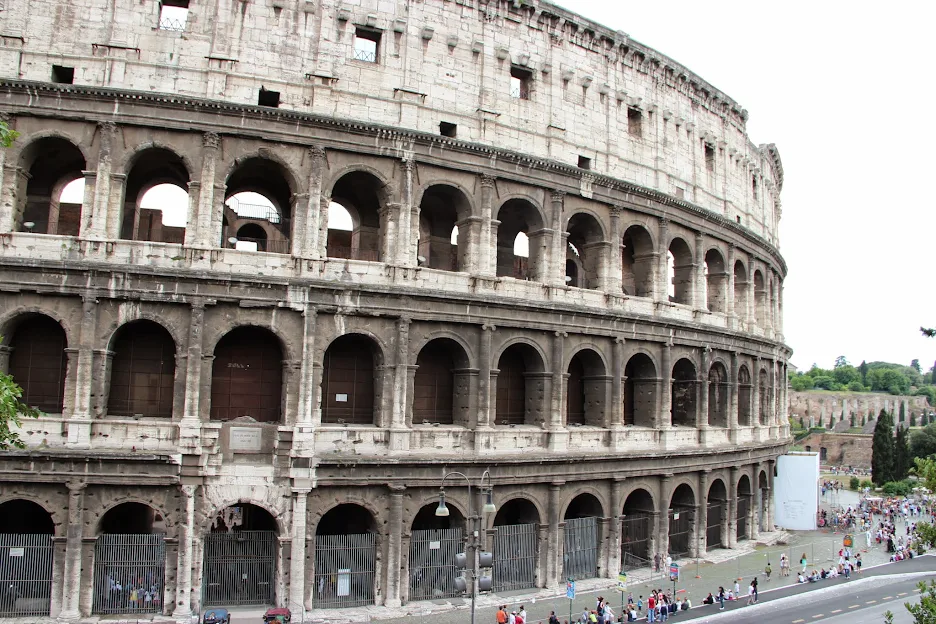

-The Colosseum ,Construction began under the emperor Vespasian in 70 AD,and was completed in 80 AD :

Roman Colosseum, Italy • 360° Aerial Panorama
http://www.airpano.ru/files/Italy-Rome-Colosseum/2-2

it would have looked like when it was built covered in marble. Beside
the Colosseum was the huge statue of Nero which was 2/3 the height
of the Colosseum.
- Rome and The Vatican in 4K Ultra HD_2018 :

The Arch of Constantine It was erected by the Roman Senate to commemorate Constantine I's victory over Maxentius at the Battle of Milvian Bridge on October 28, 312.Dedicated in 315.
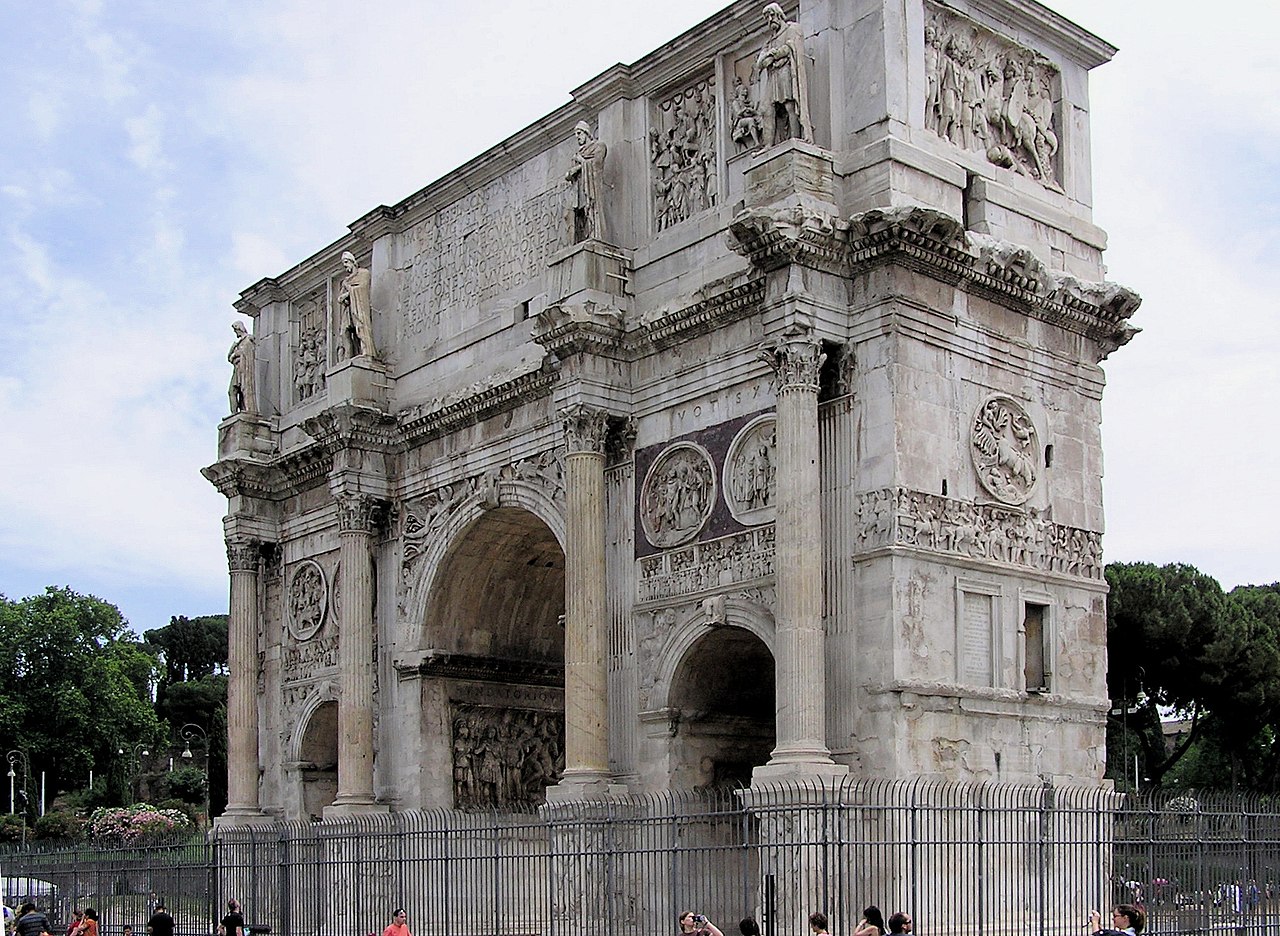
The Arch of Constantine (Italian: Arco di Costantino) is a triumphal arch in Rome, situated between the Colosseum and the Palatine Hill. It was erected by the Roman Senate to commemorate Constantine I's victory over Maxentius at the Battle of Milvian Bridge on October 28, 312. Dedicated in 315, it is the latest of the existing triumphal arches in Rome, and the only one to make extensive use of spolia, re-using several major reliefs from 2nd century imperial monuments, which give a striking and famous stylistic contrast to the sculpture newly created for the arch.
The arch spans the Via Triumphalis, the way taken by the emperors when they entered the city in triumph. This route started at the Campus Martius, led through the Circus Maximus and around the Palatine Hill; immediately after the Arch of Constantine, the procession would turn left at the Meta Sudans and march along the Via Sacra to the Forum Romanum and on to the Capitoline Hill, passing both the Arches of Titus and Septimius Severus.

The arch seen from Via Triumphalis


-VIDEO:Ben Hur 1959 Re-issue Trailer 1969 Restored in HD


-VIDEO :Popular Videos - Colosseum & Gladiator_200 videos

Colosseum - The Icon of Rome :

-VIEW : The Colosseum aerial view


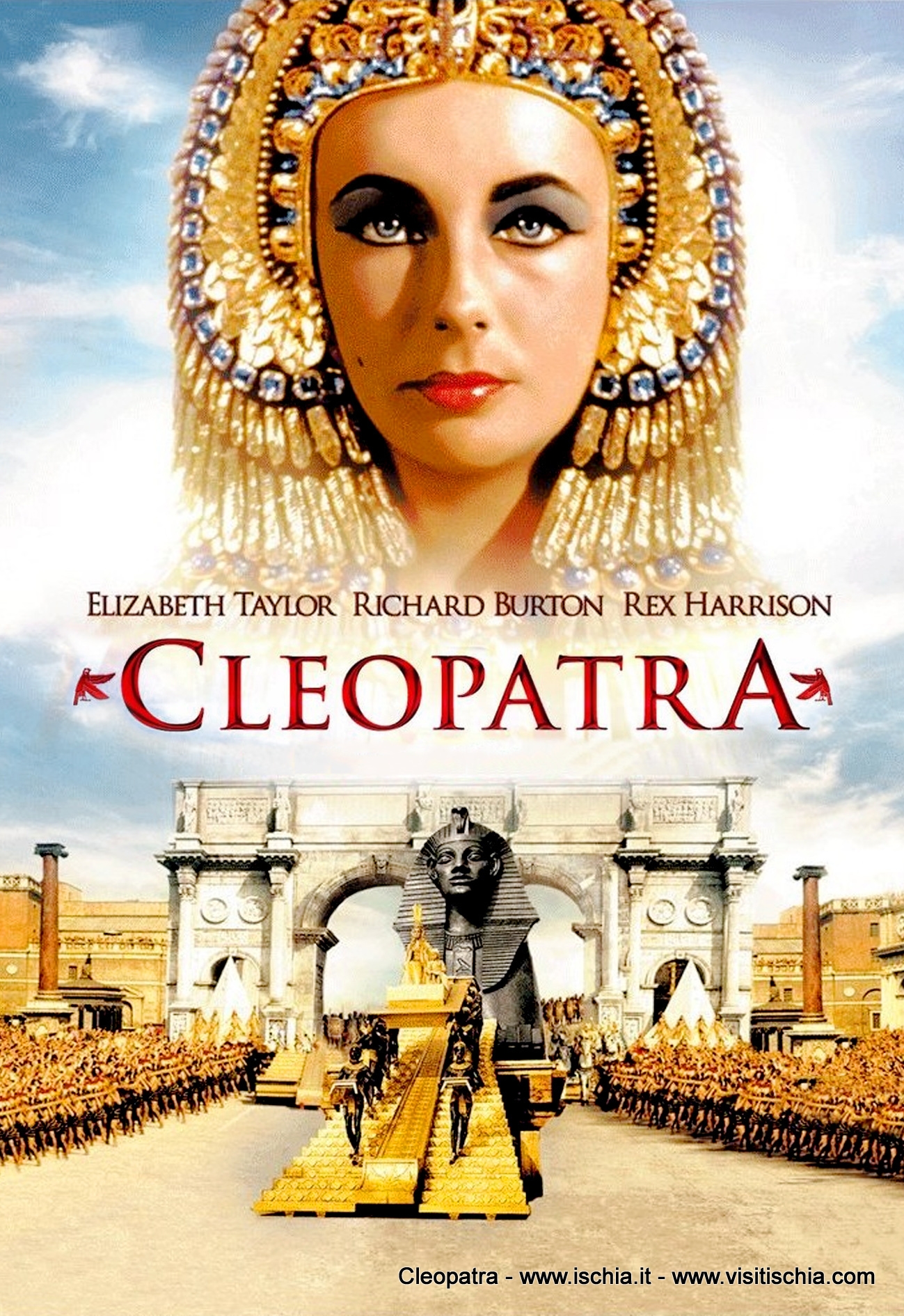
via GIPHY
Movie:Cleopatra (1963)

Cleopatra and Caesar, 1866 painting by Jean-Léon Gérôme
Cleopatra (1963 ) Elizabeth Taylor Entrance into Rome Scene (HD)
PHOTO SPHERE - Jun 2016:
-VIDEO :The Roman Colosseum: THE REAL TRUTH (HD Ancient Rome History Documentary)









The Roman Forum is a rectangula
-VIDEO : Rome, Italy: Roman Forum



Italy - Forum Romanum
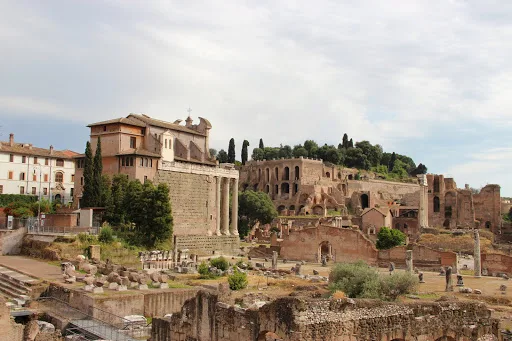
-MOVIE :Julius Caesar _ a 2002 mini-series about the life of Julius Caesar
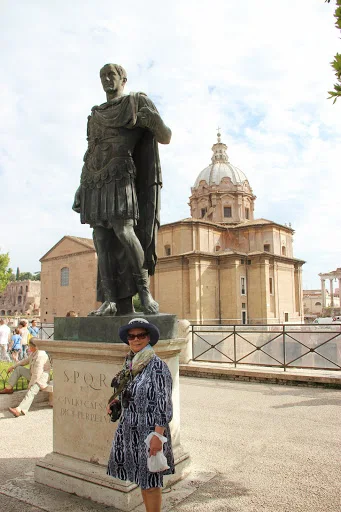
Statue of emperator Julius Caesar in Rome, Italy, wearing lorica (cuirass) and paludamentum (short military cloak).


Modern bronze statue of Julius Caesar, Rimini, Italy

Trajan's Market
-Trajan's Market was probably built in 100-110 AD by Apollodoru

At the Piazza Venezia, with Trajan's Column.
ALTARE DELLA PATRIA - PIAZZA --VENEZIA - ROME ITALY - 4K 2017 TRAVEL GUIDE
-The Altare della Patria (Altar of the Fatherland
 ) also known as the Monumento Nazionale a Vittorio Emanuele II (National Monument to Victor Emmanuel II) or "Il Vittoriano
) also known as the Monumento Nazionale a Vittorio Emanuele II (National Monument to Victor Emmanuel II) or "Il Vittoriano



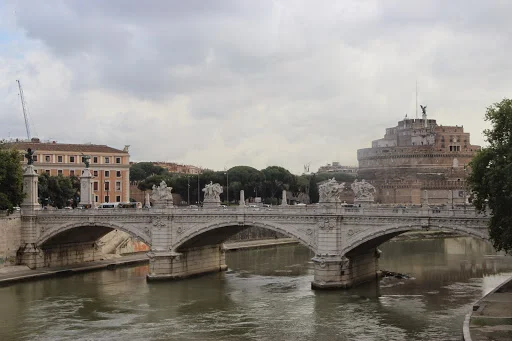
-CASTEL SANT ANGELO - ROME ITALY - 4K 2017 - TRAVEL GUIDE :

-Piazza Navona is a city square in Rome, Italy. It is built on the site of the Stadium of Domitian, built in 1st century AD :
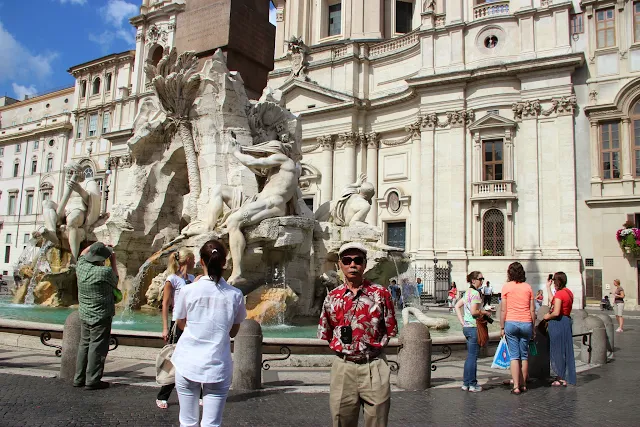
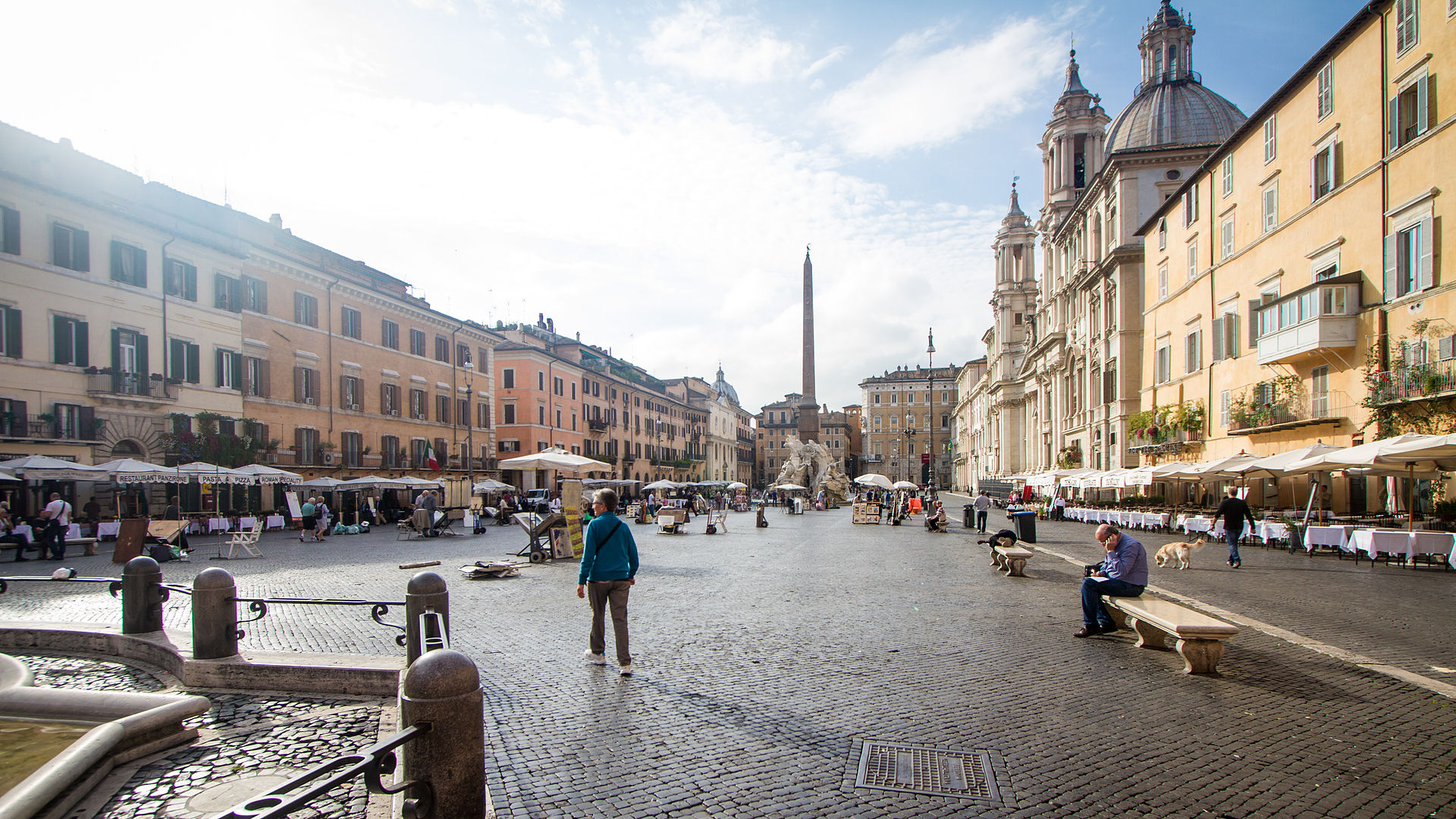
Piazza Navona 2013
Piazza Navona has two additional fountains: at the southern end is the Fontana del Moro with a basin and four Tritons sculpted by Giacomo della Porta (1575) to which, in 1673, Bernini added a statue of a Moor, or African, wrestling with a dolphin, and at the northern end is the Fountain of Neptune (1574) created by Giacomo della Porta. The statue of Neptune in the northern fountain, the work of Antonio Della Bitta, was added in 1878 to make that fountain more symmetrical with La Fontana del Moro in the south. At the southwest end of the piazza is the ancient 'speaking' statue of Pasquino. Erected in 1501, Romans could leave lampoons or derogatory social commentary attached to the statue. During its history, the piazza has hosted theatrical events and other ephemeral activities. From 1652 until 1866, when the festival was suppressed, it was flooded on every Saturday and Sunday in August in elaborate celebrations of the Pamphilj family. The pavement level was raised in the 19th century and the market was moved again in 1869 to the nearby Campo de' Fiori. A Christmas market is held in the piazza.
-PIAZZA NAVONA - ROME - ITALY - 4K 2017 TRAVEL GUIDE :

Piazza Navona, Rome, Italy in 2006
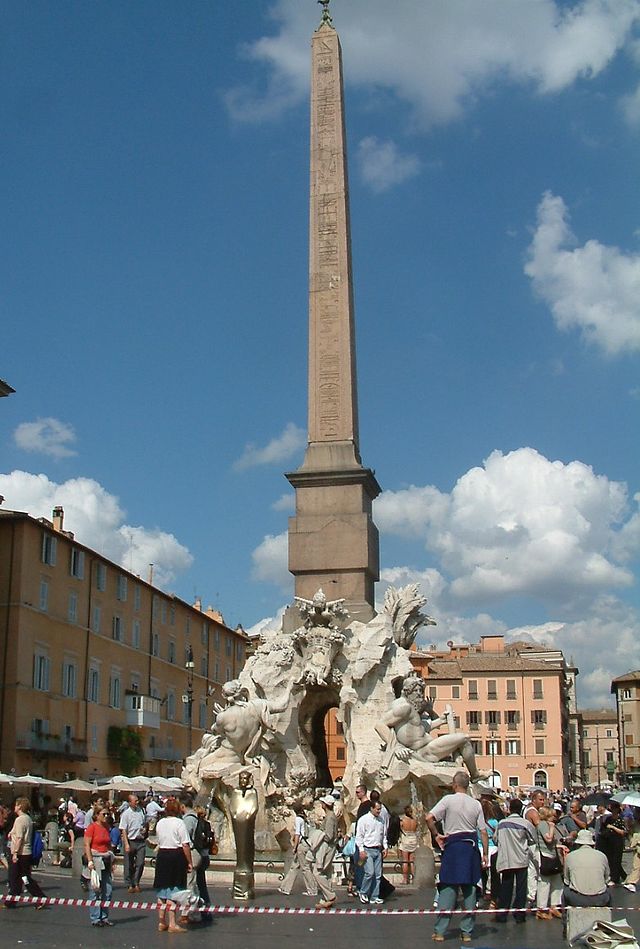
Fountain of the four Rivers with Egyptian obelisk, in the middle of Piazza Navona

Fontana dei Quattro Fiumi on Piazza Navona 2013
Piazza Navona Rome Italy February 2013
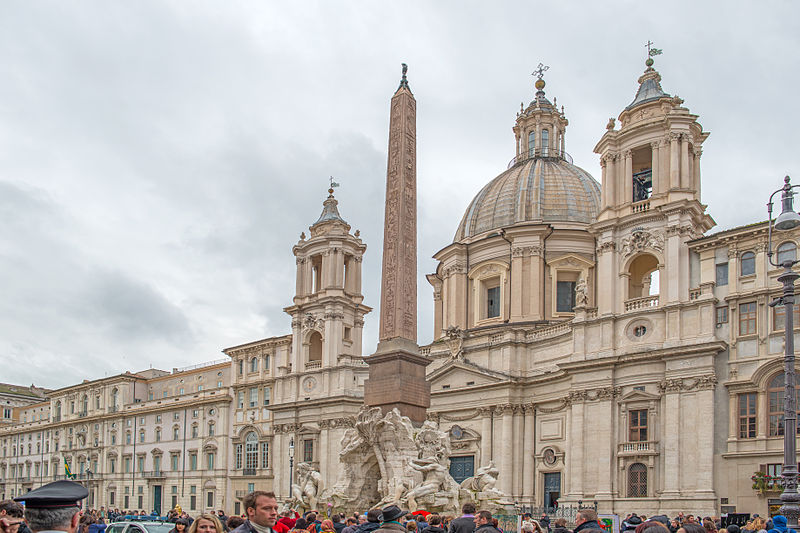
Piazza Navona 2013_Fountain of the four Rivers with Egyptian obelisk, in the middle of Piazza Navona


Fontana dei Quattro Fiumi on Piazza Navona 2013

Piazza Navona looking northwards

The Spanish Steps (Italian: Scalinata della Trinità dei Monti) are a set of steps in Rome, Italy, climbing a steep slope between the Piazza di Spagna at the base and Piazza Trinità dei Monti, dominated by the Trinità dei Monti church at the top. The Scalinata is the widest staircase in Europe
The Spanish Steps (Italian: Scalinata della Trinità dei Monti) are a set of steps in Rome, Italy, climbing a steep slope between the Piazza di Spagna at the base and Piazza Trinità dei Monti, dominated by the Trinità dei Montichurch at the top. The Scalinata is the widest staircase in Europe.
The monumental stairway of 135 steps was built with French diplomat Étienne Gueffier’s bequeathed funds of 20,000 scudi, in 1723–1725, linking the Bourbon Spanish Embassy, and the Trinità dei Monti church that was under the patronage of the Bourbon kings of France, both located above — to the Holy See in Palazzo Monaldeschi located below. The stairway was designed by architects Francesco de Sanctis and Alessandro Specchi.


-Fontana della Barcaccia by Pietro and Gian Lorenzo Bernini, Piazza di Spagna, Rome, was completed in 1627.It is so named because it is in the shape of a half-sunken ship with water overflowing its bows.

The monumental stairway of 135 steps was built with French diplomat Étienne Gueffier’s bequeathed funds of 20,000 scudi, in 1723–1725




AUDREY HEPBURN


AUDREY HEPBURN
-The Pantheona temple to all the gods of ancient Rome, and rebuilt by the emperor Hadrian about 126 AD :

The Pantheon (/ˈpænθiən/ or US /ˈpænθiɒn/; Latin: Pantheon, [pantʰewn] from Greek:Πάνθεον [ἱερόν], an adjective understood as "[temple consecrated] to all gods") is a building in Rome,Italy, commissioned by Marcus Agrippa during the reign of Augustus as a temple to all the gods of ancient Rome, and rebuilt by the emperor Hadrian about 126 AD.
The building is circular with a portico of large granite Corinthian columns (eight in the first rank and two groups of four behind) under a pediment. A rectangular vestibule links the porch to the rotunda, which is under a coffered concrete dome, with a central opening (oculus) to the sky. Almost two thousand years after it was built, the Pantheon's dome is still the world's largest unreinforced concrete dome. The height to the oculus and the diameter of the interior circle are the same, 43.3 metres (142 ft).
It is one of the best-preserved of all Roman buildings. It has been in continuous use throughout its history, and since the 7th century, the Pantheon has been used as a Roman Catholic church dedicated to "St. Mary and the Martyrs" but informally known as "Santa Maria Rotonda." The square in front of the Pantheon is called Piazza della Rotonda.
-PANTHEON - ROME - ITALY - 4K 2017 - TRAVEL GUIDE :

The Pantheon dome. The concrete for the coffered dome was poured in moulds, probably mounted on temporary scaffoldin




-Trevi Foun

Trevi Fountain (Italian: Fontana di Trevi) is a fountain in the Trevi district in Rome, Italy, designed by Italian architect Nicola Salvi and completed by Pietro Bracci. Standing 26.3 metres (86 ft) high and 49.15 metres (161.3 ft) wide, it is the largest Baroque fountain in the city and one of the most famous fountains in the world. The fountain has appeared in several notable films, including Federico Fellini's La Dolce Vita and is a popular tourist attraction.

-VIDEO : Trevi Fountain, Rome [HD]

The Trevi Fountain is a fountain in the Trevi district in Rome, Italy. Standing 26.3 metres (86 ft) high and 49.15 metres (161.3 ft) wide,[1] it is the largest Baroque fountain in the city and one of the most famous fountains in the world.


Italy - Trevi fountain, Rome
-2013_06_10_St. Peter's Basilica_Vatican :
-Click on :Vatican City State • 360° Aerial Panorama
http://www.airpano.ru/files/Vatican/2-2




-Click on : Papal Basilica of Saint Peter :
http://ww
-The Last Judgment (Michelangelo):

-Click on :
 Sistine Chapel 3D Tour
Sistine Chapel 3D Tour
-VIDEO : Sistine Chapel - Michelangelo
-Sistine Chapel: Last Judgment by Michelangelo - 3D virtual tour & documentary :

The Vatican Museums (Italian: Musei Vaticani) are the museums of the Vatican City and are located within the city's boundaries



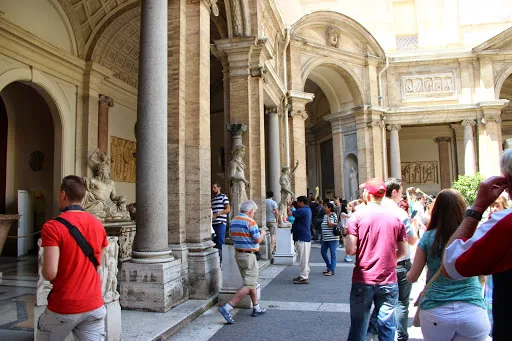



-VATICAN MUSEUMS - VATICAN, ROME 2017 4K

Vatican City at Large
St. Peter's Basilica from ponte Umberto I, on the Tiber. The iconic dome dominates the skyline of Rome.
St. Peter's Basilica, believed to be the burial site of St. Peter, seen from the River Tiber. The iconic dome dominates the skyline of Rome. St. Peter's Basilica from the River Tiber. The iconic dome dominates the skyline of Rome. Saint Peter's Basilica in Rome. Christianity became the dominant religion of Western Civilization when the Roman Empire converted to Christianity. St. Peter's Basilica, believed to be the burial site of St. Peter, seen from the River Tiber. Saint Peter's Basilica.
PHOTO SPHERE - Jul 2016:
-A rare look at the Vatican Library's treasures_CBS News :

Panorama of St. Peter's Square
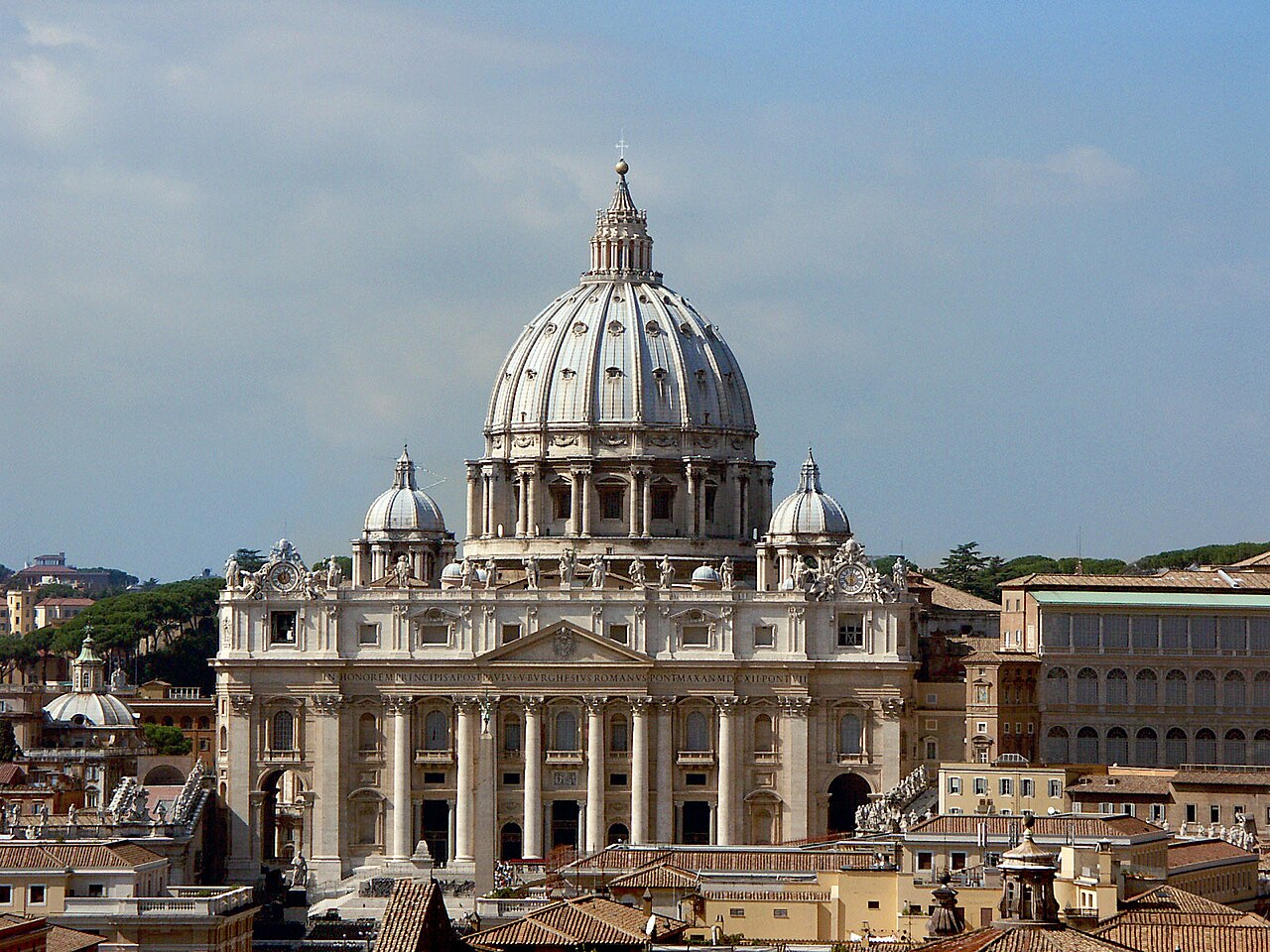
St. Peter's Basilica in Rome seen from the roof of Castel Sant'Angelo.

Maderno’s façade, with the statues of Sts Peter (left) & Paul (right) flanking the entrance stairs
Façade of the St. Peter's Basilica in Vatican City.

St. Peter's Basilica and the piazza at night
St. Peter's Basilica (Latin: Basilica Sancti Petri; Italian: Basilica di San Pietro in Vaticano) is aLate Renaissance church located within Vatican City.
Designed principally by Donato Bramante, Michelangelo, Carlo Maderno and Gian Lorenzo Bernini, St. Peter's is the most renowned work of Renaissance architecture and remains one of the largest churches in the world. While it is neither the mother church of the Roman Catholic Church nor the cathedral of the Bishop of Rome, St. Peter's is regarded as one of the holiest Catholic sites. It has been described as "holding a unique position in the Christian world" and as "the greatest of all churches of Christendom".
By Roman Catholic tradition, the basilica is the burial site of its namesake Saint Peter, one of the twelve apostles of Jesus and, also according to tradition, the first Bishop of Rome and therefore first in the line of the papal succession. Tradition and some historical evidence hold that Saint Peter's tomb is directly below the altar of the basilica. For this reason, many Popes have been interred at St. Peter's since the Early Christian period. There has been a church on this site since the time of Constantine the Great. Construction of the present basilica, replacing the Old St. Peter's Basilica of the 4th century, began on 18 April 1506 and was completed on 18 November 1626.
St. Peter's is famous as a place of pilgrimage, for its liturgical functions. Because of its location in the Vatican, the Pope presides at a number of services throughout the year, drawing audiences of 15,000 to over 80,000 people, either within the Vatican Basilica, or in St. Peter's Square. St. Peter's has many strong historical associations, with the Early Christian church, the papacy, the Protestant Reformation and Counter-reformation, and with numerous artists, most significantly Michelangelo. As a work of architecture, it is regarded as the greatest building of its age. St. Peter's is one of the four churches of Rome that hold the rank of Major Basilica. Contrary to popular misconception, it is not a cathedral as it is not the seat of a bishop; thecathedra of the Pope (as Bishop of Rome) is located in the Archbasilica of St. John Lateran.
ST. PETER'S BASILICA - VATICAN, ROME 2017 4K :

St. Peter's Basilica (Latin: Basilica Sancti Petri; Italian: Basilica di San Pietro in Vaticano) is a Late Renaissanc
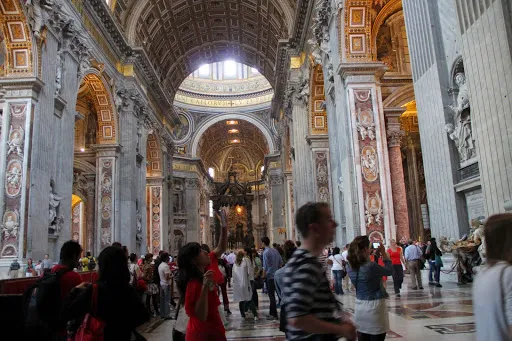
Designed principall

Crepuscular rays are regularly seen in St. Peter's Basilica at certain times each day.

Maderno's nave, looking towards the chancel

The apse with St. Peter's Cathedral supported by four Doctors of the Church
Saint Peter's Basilica, the apse, showing the Catedra of St Peter supported by four Doctors of the Church, and the Glory, designed by Bernini.

By Roman Catholic tradition, the basilica is the burial site of its namesake Saint Peter, one of the twelve apostles of Jesus and, also according to tradition, the first Bishop of Rome and therefore first in the line of the papal succession

Tradition and some historical evidence hold that Saint Peter's tomb is directly below the altar of the basilica

For this reason, many Popes have been interred at St. Peter's since the Early Christian period. There has been a church on this site since the time of Constantin

St. Peter's is famous as a place of pilgrimage

St. Peter's is one of the four churches of Rome that hold the rank of Major Basilica

The Pietà (1498–1499



-Pope John XXIII had just been moved up to the Basilica floor to make room for Pope John Paul II in the basement tombs:

-The statue of Saint Peter. Bronze. Unknown size. 1300. Treasury of San Pietro, Vatican :

The statue of Saint Peter. Bronze. Unknown size. 1300. Treasury of San Pietro, Vatican

The dome was brought to completion by Giacomo della Porta and Fontana.

-St. Peter's Basilica :



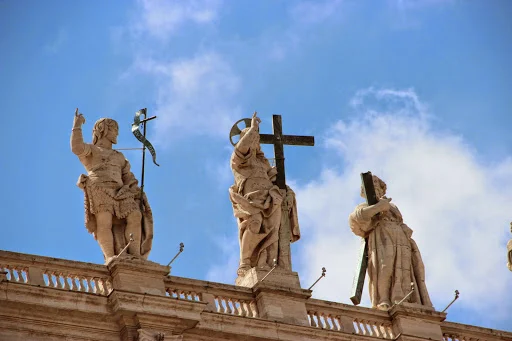
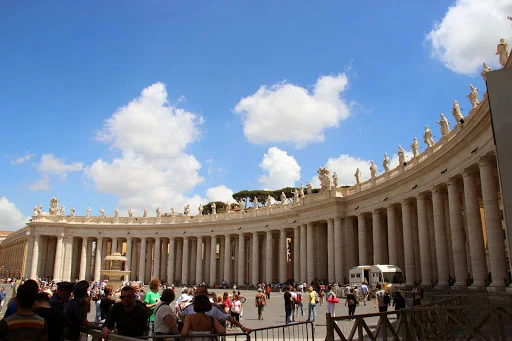


Panorama of St Peter's Square in Vatican City. Panorama created using Hugin/Panotools and enblend_By François Malan_4 May 2005.



-VATICAN - VATICAN CITY 2017 4K :

-St Peter's Square_V
-VIDEO : Vatican City Explained
-VIDEO :The History of Rome, the Holy City (Documentary)
-VIDEO:Rome and The Vatican in 4K Ultra HD_ Amazing Places in 4K Ultra HD | Amazing Places on Our Planet.

2013_06_10

2013_06_10
ROMA - Arrivederci Roma (Goodbye to Rome) Claudio Villa :
-ROME - ITALY , BEST OF ROME 2017 4K :
-2013_06_11_Duomo In Florence_Italy:
-Florence (Italian: Firenze [fiˈrɛntse] ( listen), alternative obsolete form: Fiorenza; Latin: Florentia) is the capital city of the Italian region of Tuscany and of the province of Florence. It is the most populous city in Tuscany, with approximately 370,000 inhabitants, expanding to over 1.5 million in the metropolitan area.
listen), alternative obsolete form: Fiorenza; Latin: Florentia) is the capital city of the Italian region of Tuscany and of the province of Florence. It is the most populous city in Tuscany, with approximately 370,000 inhabitants, expanding to over 1.5 million in the metropolitan area.
Florence is famous for its history. A centre of medieval European trade and finance and one of the wealthiest cities of the time, Florence is considered the birthplace of the Renaissance, and has been called "the Athens of the Middle Ages".A turbulent political history includes periods of rule by the powerful Medici family, and numerous religious and republican revolutions.[ From 1865 to 1871 the city was also the capital of the recently established Kingdom of Italy.
The historic centre of Florence attracts millions of tourists each year, and Euromonitor International ranked the city as the world's 72nd most visited in 2009, with 1,685,000 visitors. It was declared a World Heritage Site by UNESCO in 1982. Due to Florence's artistic and architectural heritage, it has been ranked by Forbes as one of the most beautiful cities in the world, and the city is noted for its history, culture, Renaissance art and architecture and monuments. The city also contains numerous museums and art galleries, such as the Uffizi Gallery and the Pitti Palace, amongst others, and still exerts an influence in the fields of art, culture and politics.
Florence is also an important city in Italian fashion, being ranked within the top fifty fashion capitals of the world;[ furthermore, it is also a major national economic centre, being a tourist and industrial hub. In 2008, the city had the 17th highest average income in Italy.
Florence is famous for its history. A centre of medieval European trade and finance and one of the wealthiest cities of the time, Florence is considered the birthplace of the Renaissance, and has been called "the Athens of the Middle Ages".A turbulent political history includes periods of rule by the powerful Medici family, and numerous religious and republican revolutions.[ From 1865 to 1871 the city was also the capital of the recently established Kingdom of Italy.
The historic centre of Florence attracts millions of tourists each year, and Euromonitor International ranked the city as the world's 72nd most visited in 2009, with 1,685,000 visitors. It was declared a World Heritage Site by UNESCO in 1982. Due to Florence's artistic and architectural heritage, it has been ranked by Forbes as one of the most beautiful cities in the world, and the city is noted for its history, culture, Renaissance art and architecture and monuments. The city also contains numerous museums and art galleries, such as the Uffizi Gallery and the Pitti Palace, amongst others, and still exerts an influence in the fields of art, culture and politics.
Florence is also an important city in Italian fashion, being ranked within the top fifty fashion capitals of the world;[ furthermore, it is also a major national economic centre, being a tourist and industrial hub. In 2008, the city had the 17th highest average income in Italy.
-Click on :Florence, Italy • 360° Aerial Panorama
http://www.airpano.ru/files/Florence-Italy/2-2
-VIDEO :Florence: Heart of the Renaissance_ Rick Steves' Europe

The Ponte Vecchio ("Old Bridge", Italian pronunciation: [ˈponte ˈvɛkkjo]) is aMedieval stone closed-spandrel segmental arch bridge over the Arno River, inFlorence, Italy, noted for still having shops built along it, as was once common. Butchers initially occupied the shops; the present tenants are jewellers, art dealers and souvenir sellers.

PHOTO SPHERE - Aug 2016:



The narrow courtyard between the Uffizi's two wings creates the effect of a short, idealized street.
The Uffizi Gallery (Italian: Galleria degli Uffizi, Italian pronunciation: [ˌɡalleˈria deʎʎi ufˈfittsi]) is a museum in Florence, Italy. It is one of the oldest and most famous art museums of the Western world.

Raphael, Madonna of the Goldfinch

Leonardo da Vinci, The Annunciation

Sandro Botticelli,Primavera
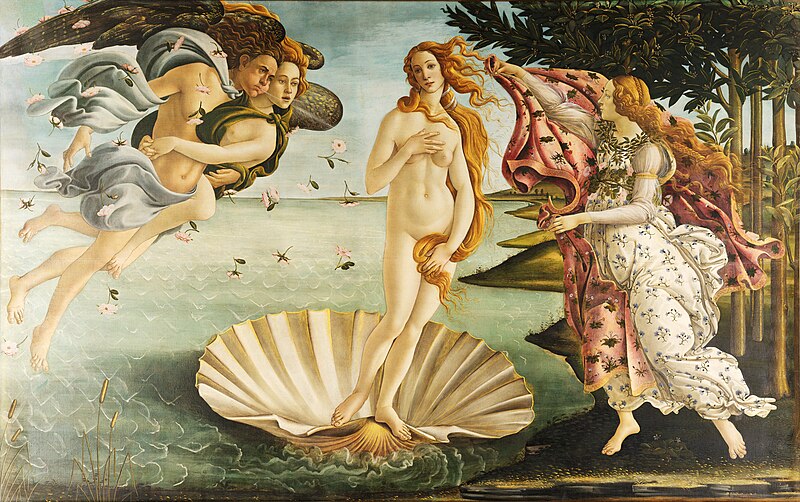
The Birth of Venus (Italian: Nascita di Venere) is a 1486 painting by Sandro Botticelli. Botticelli was commissioned to paint the work by the Medici family of Florence, specifically Lorenzo di Pierfrancesco de' Medici under the influence of his cousin Lorenzo de' Medici, close friend to Botticelli . It depicts the goddess Venus, having emerged from the sea as a fully grown woman, arriving at the sea-shore (which is related to the Venus Anadyomene motif). The painting is on display at the Uffizi Gallery in Florence, Italy.
-VIEW :Virtual Tour Uffizi Gallery


The graceful Loggia dei Lanzi, which sits to the right of Palazzo Vecchio and functions as an open-air sculpture gallery, was designed by Orcagna in 1376. Its curved arches foretell Renaissance classicism. The statue of Perseo holding Medusa's head, by Benvenuto Cellini (1554):

The Palazzo della Signoria, better known as the Palazzo Vecchio (English:The Old Palace) :Overlooking the square with Michelangelo's David statue (1501–1504) And Hercules and Cacus by Baccio Bandinelli.


Equestrian statue of Cosimo I .

The Fountain of Neptune is a fountain in Florence, Italy, situated on the Piazza della Signoria (Signoria square), in front of the Palazzo Vecchio. The fountain was commissioned in 1565 and is the work of the sculptor Bartolomeo Ammannati.

Palazzo Vecchio overlooks piazza della Signoria





The Basilica di Santa Maria del Fiore (English: Basilica of Saint Mary of the Flower) is the main church of Florence, Italy. Il Duomo di Firenze, as it is ordinarily called, was begun in 1296 in the Gothic style to the design of Arnolfo di Cambio and completed structurally in 1436 with the dome engineered by Filippo Brunelleschi. The exterior of the basilica is faced with polychrome marblepanels in various shades of green and pink bordered by white and has an elaborate 19th-century Gothic Revival façade by Emilio De Fabris.
The cathedral complex, located in Piazza del Duomo, includes the Baptistery and Giotto's Campanile. The three buildings are part of the UNESCO World Heritage Site covering the historic centre of Florence and are a major attraction to tourists visiting the region of Tuscany. The basilica is one of Italy's largest churches, and until development of new structural materials in the modern era, the dome was the largest in the world. It remains the largest brick dome ever constructed.
The cathedral is the mother church of the Roman Catholic Archdiocese of Florence, whose archbishop is currently Giuseppe Betori.
The cathedral complex, located in Piazza del Duomo, includes the Baptistery and Giotto's Campanile. The three buildings are part of the UNESCO World Heritage Site covering the historic centre of Florence and are a major attraction to tourists visiting the region of Tuscany. The basilica is one of Italy's largest churches, and until development of new structural materials in the modern era, the dome was the largest in the world. It remains the largest brick dome ever constructed.
The cathedral is the mother church of the Roman Catholic Archdiocese of Florence, whose archbishop is currently Giuseppe Betori.

The Basilica di Santa Maria del Fiore (English: Basilica of Saint Mary of the Flower) is the main church of Florence, Italy. The Duomo, as it is ordinarily called, was begun in 1296 in the Gothic style to the design of Arnolfo di Cambio and completed structural


The cathedral complex, located in Piazza del Duomo, includes the Baptistery and Giotto's Campanile. The three buildings are part of the UNESCO World Heritage

The basilica is one of Italy's largest churches, and until developmen

Site covering the historic centre of Florence and are a major attraction to tourists visiting the region of Tuscany


- Baptistery

Basilica of Saint Mary of the Flower Basi
2013_06_11_Inside Basilica of Saint Mary of the Flower(Duomo)

The famous cathedral dome dominates the skyline of Florence,t

The Medici : Richer than the Rockefelle
-VIDEO : Medici_2013.
-View : -The House of Medici
The Piazza della Repubblica is a square in the city centre, location of the cultural cafes and bourgeois palaces. Among the square's cafes (like Caffè Gilli, Paszkowski or the Hard Rock Cafè), the Giubbe Rosse cafe has long been a meeting place for artists and writers, notably those of Futurism.


Bust of Benvenuto Cellini on the Ponte Vecchio, Florence
-VIDEO:PONTE VECCHIO ("Old Bridge")-Florence, Italy_ Nov 1, 2018.

The Ponte Vecchio ("Old Bridge", Italian pronunciat


Benvenuto Cellini (Italian pronunciat

The Palazzo Pitti (Italian pronunciation: [paˈlattso ˈpitti]), in English sometimes called the Pitti Palace, is a vast mainly Renaissancepalace in Florence, Italy. It is situated on the south side of theRiver Arno, a short distance from the Ponte Vecchio. The core of the present palazzo dates from 1458 and was originally the town residence of Luca Pitti, an ambitious Florentine banker.
The palace was bought by the Medici family in 1549 and became the chief residence of the ruling families of the Grand Duchy of Tuscany. It grew as a great treasure house as later generations amassed paintings, plates, jewelry and luxurious possessions.
In the late 18th century, the palazzo was used as a power base by Napoleon, and later served for a brief period as the principal royal palace of the newly united Italy. The palace and its contents were donated to the Italian people by King Victor Emmanuel III in 1919, and its doors were opened to the public as one of Florence's largest art galleries.
-VIDEO : Colorslide Tour of the Pitti Palace

-VIDEO :The Medici - Secrets of the most Powerful Family in the World (Full Documentary)

-View : -The House of Medici
-VIDEO :The Medici - Godfathers of the Renaissance 1/4

Tourists flock to the Fontana del Porcellino.




Piazzale Michelange
It was built in 1869 and designed by architect Giuseppe Poggi on a hill just south of the historic center, during the redevelopm

The square, dedicated to the great Renaissanc
Poggi designed the loggia in the neoclassic


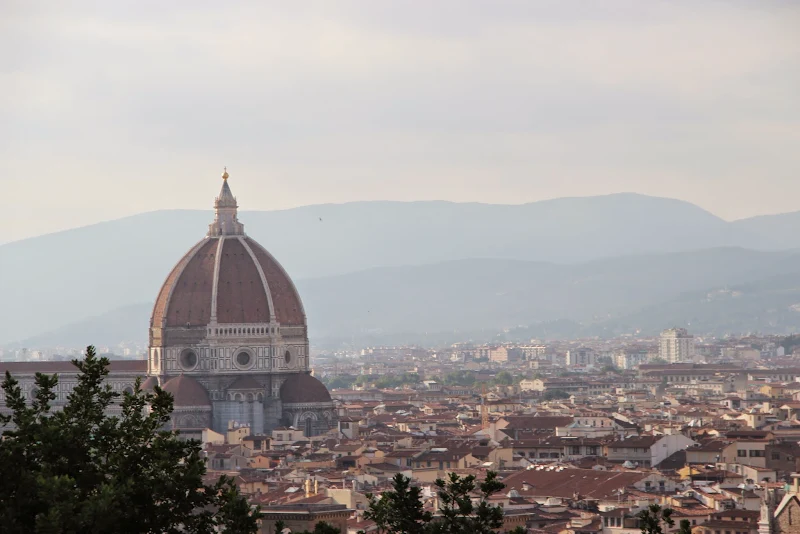
The panorama embraces the heart of Florence from Forte Belvedere to Santa Croce, across the lungarni and the bridges crossing the Arno, including the Ponte Vecchio, the Duomo, Palazzo Vecchio, the Bargello and the octagonal bell tower of the Badia Fiorentina
The Piazzale Michelange

Viewing from Piazzale Michelange


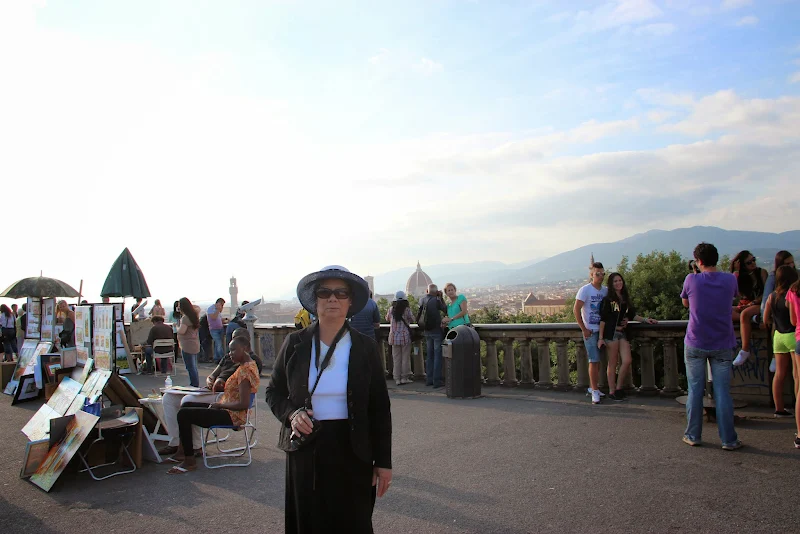

Dinner at La Certosa Ristorante_Address: Via Cassia, 1, 50124 Impruneta FI, Italy.
https://www.facebook.com/pg/certosaristorante/photos/?ref=page_internal



Live Music

-VIDEO :Florence, Italy_April 18-20_2013.
-Florence, Italy in 4K Ultra HD _ Feb 16, 2018.
2013_06_12_Leaning Tower of
Pisa_Tuscany_Italy :
The Leaning Tower of Pisa(Italian: Torre pendente di Pisa) or simply the Tower of Pisa (Torre di Pisa) is the campanile, or freestanding bell tower, of the cathedral of the Italian city of Pisa, known worldwide for its unintended tilt to one side. It is situated behind the Cathedral and is the third oldest structure in Pisa's Cathedral Square (Piazza del Duomo) after the Cathedral and the Baptistry. The tower's tilt began during construction, caused by an inadequate foundation on ground too soft on one side to properly support the structure's weight. The tilt increased in the decades before the structure was completed, and gradually increased until the structure was stabilized (and the tilt partially corrected) by efforts in the late 20th and early 21st centuries.
The height of the tower is 55.86 metres (183.27 feet) from the ground on the low side and 56.67 metres (185.93 feet) on the high side. The width of the walls at the base is 2.44 m (8 ft 0.06 in). Its weight is estimated at 14,500 metric tons (16,000 short tons). The tower has 296 or 294 steps; the seventh floor has two fewer steps on the north-facing staircase. Prior to restoration work performed between 1990 and 2001, the tower leaned at an angle of 5.5 degrees, but the tower now leans at about 3.99 degrees. This means that the top of the tower is displaced horizontally 3.9 metres (12 ft 10 in) from where it would be if the structure were perfectly vertical
The height of the tower is 55.86 metres (183.27 feet) from the ground on the low side and 56.67 metres (185.93 feet) on the high side. The width of the walls at the base is 2.44 m (8 ft 0.06 in). Its weight is estimated at 14,500 metric tons (16,000 short tons). The tower has 296 or 294 steps; the seventh floor has two fewer steps on the north-facing staircase. Prior to restoration work performed between 1990 and 2001, the tower leaned at an angle of 5.5 degrees, but the tower now leans at about 3.99 degrees. This means that the top of the tower is displaced horizontally 3.9 metres (12 ft 10 in) from where it would be if the structure were perfectly vertical
-Click on :Leaning Tower of Pisa, Tuscany, Central Italy • 360° Aerial Panorama
PHOTO SPHERE - Jun 2013:





The tower's tilt began during constructi

The height of the tower is 55.86 m (183.27 ft) from the ground on the low side and 56.70 m (186.02 ft) on the high side. The width of the walls at the base is 4.09 m (13.42 ft) and at the top 2.48 m (8.14 ft). Its weight is estimated at 14,500 metric tons (16,000 short tons). The tower has 296 or 294 steps; the seventh floor has two fewer steps on the north-faci


Prior to restoratio
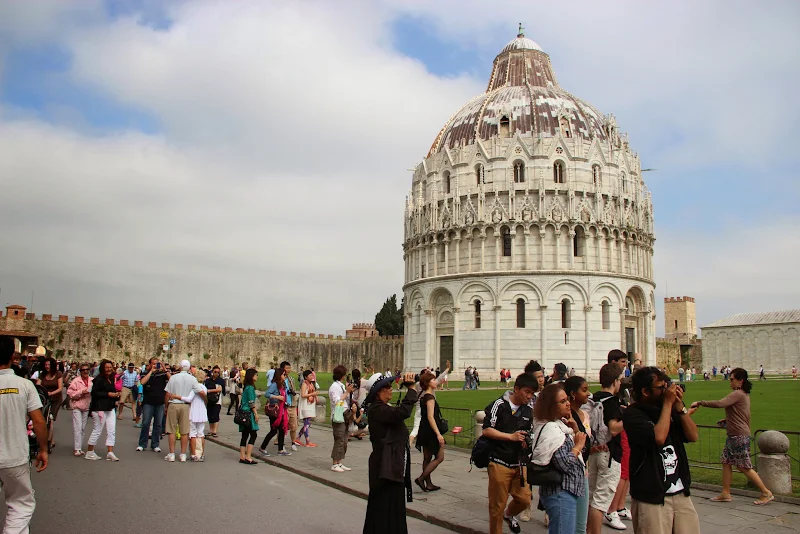
The Pisa Baptistry





The Leaning Tower of Pisa (Italian: Torre pendente di Pisa)





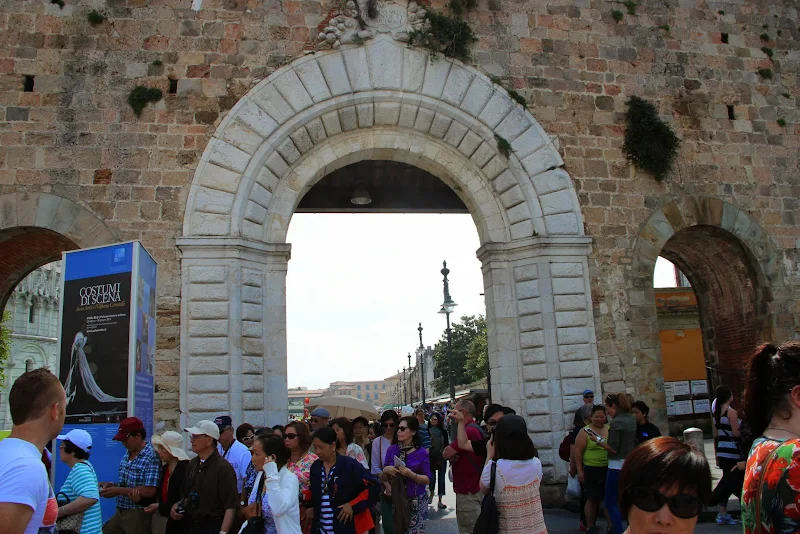
-Piazza dei Miracoli, Pisa, Italy in 4K Ultra HD_2017 :
-VIDEO : Rick Steves Full Episodes_84 videos


At the quiet Square Edouard VII, (a home to the Théâtre Edouard VII and many restaurants and offices ) and a statue of British King Edward VII (1901-1910) stands in its center.

At the Square Edouard VII (Paris’s ninth arrondissement_France)_June 16_2013.
- My Photo Album : Visiting Switzerland (Rheinfall_Lucerne_Lugano), Germany(Titisee )
Italy(Lake Garda_Verona_Venice_Rome_Vatican_
Florence_Pisa) :
-Keep on traveling .... Europe Trip _Part # 3 : Bald Eagle: Beautiful Europe





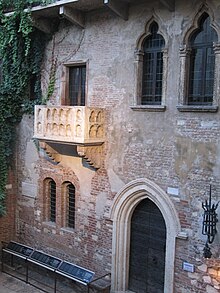


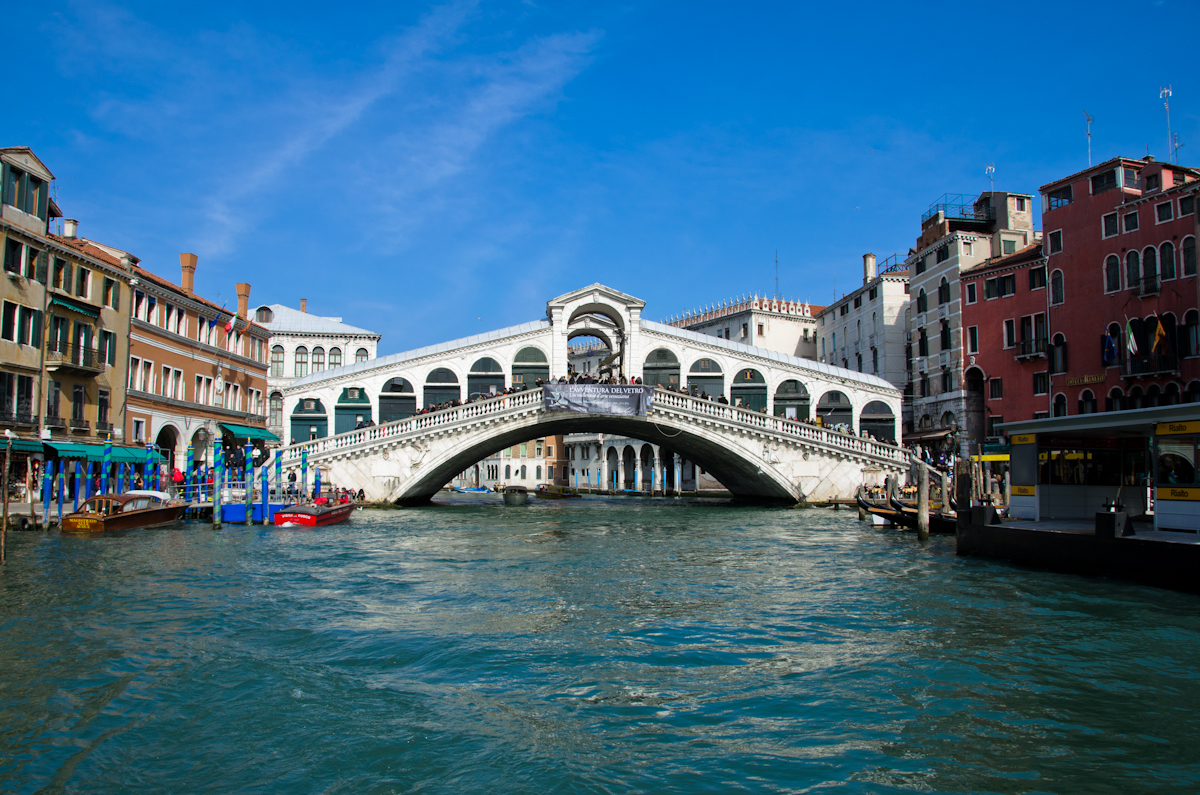




No comments:
Post a Comment